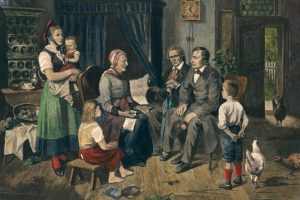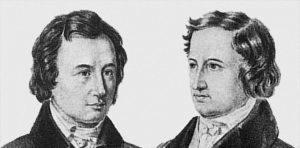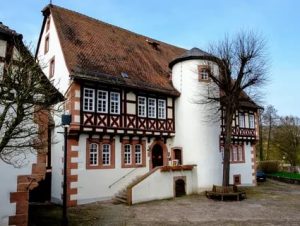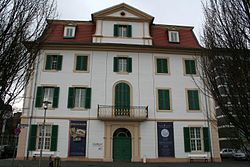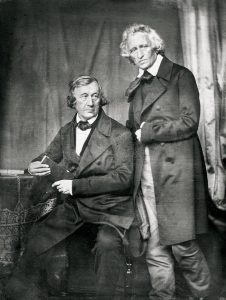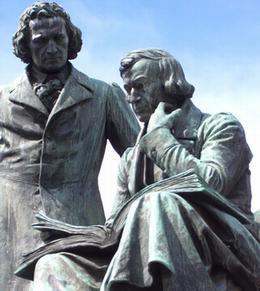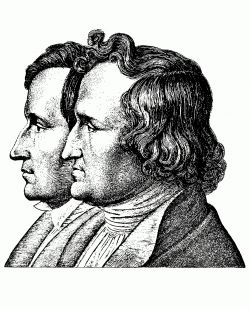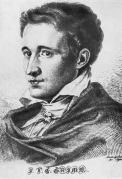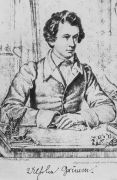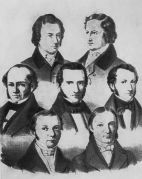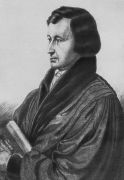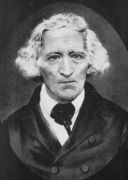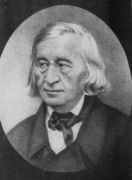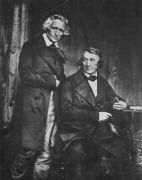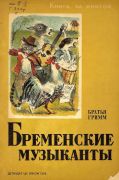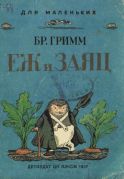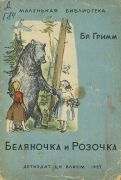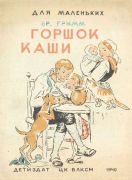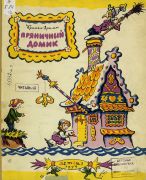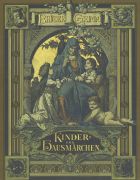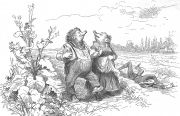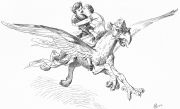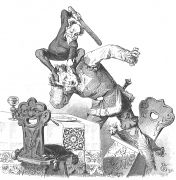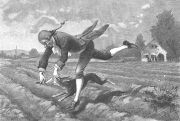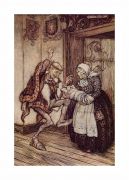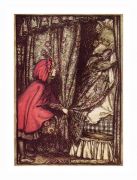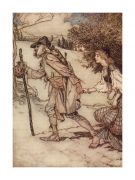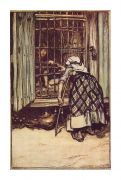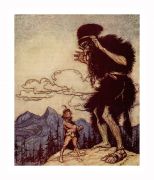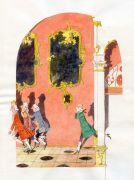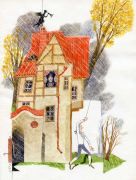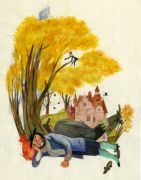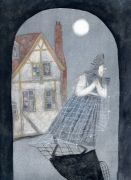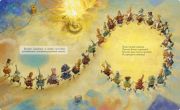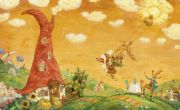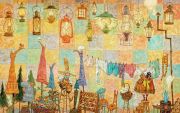Биография
Братья Гримм – немецкие сказочники, лингвисты, отцы-основатели германской филологии. Пожалуй, сложно будет найти человека, который ни разу не слышал сказок этих великих писателей. Но если не слышал, то непременно видел. По сюжетам произведений братьев Гримм сняты десятки фильмом и мультфильмов, поставлено немало спектаклей. А некоторые персонажи их сказок стали и вовсе именами нарицательными – Золушка, Рапунцель, Спящая красавица.
Детство и юность
Якоб Гримм родился 4 января 1785 года, а через год – 24 февраля 1786 года – на свет появился Вильгельм Гримм. Их отец Филипп Вильгельм Гримм работал адвокатом в Надворном суде города Ханау. В 1791 году его назначили на должность начальника округа Штайнау, куда и пришлось переехать всей его семье. Мужчина работал днями и ночами, в результате усталости и переутомления обыкновенная простуда переросла в пневмонию. В 1796 году он скончался, ему было 44 года.
Разумеется, для семьи Гримм это стало трагедией. Доротея Гримм – мать братьев – осталась одна с шестью детьми. В это время к ним переехала сестра отца – Шарлотта Шлеммер, именно она оказала финансовую помощь семье и спасла от выселения из дома.
Но к Гримм вновь пришла беда – тетушка Шлеммер неожиданно слегла и скоропостижно скончалась. Якоб и Вильгельм были старшими детьми, и им пришлось взять часть обязанностей матери на себя. Но Доротея понимала, что мальчики умны и талантливы, и единственное, что она может им дать, это образование.
В Касселе жила ее сестра – Генриетта Циммер, женщина согласилась принять любимых племянников у себя, чтобы они продолжили учебу в лицее высшей ступени. В гимназии ученики обучались 7-8 лет. Но братья были настолько трудолюбивы и усидчивы, что им удалось овладеть материалом в разы быстрее остальных. Поэтому лицей они закончили уже через четыре года.
В школе мальчики изучали естествознание, географию, этику, физику и философию, но основу преподавания составляли филологические и исторические дисциплины. Якобу все же учеба давалась проще, чем брату. Возможно, что причиной тому было его крепкое здоровье. Вильгельму же диагностировали астму.
В 1802 году Якоб поступил в Марбургский университет на юриста, а вот Вильгельму пришлось остаться, чтобы пройти лечение. На следующий год Якоб перевез брата в Марбург, и он тоже поступил в университет. Правда, ему требовалось регулярное врачебное наблюдение.
В свободное время братья любили рисовать, однажды картины увидел их младший брат Людвиг Эмиль, который так вдохновился этим делом, что свое будущее связал с художественным ремеслом, став популярным в Германии гравером и художником.
Литература
Братья Гримм всегда интересовались литературой. При всем при том, что окончили они юридический факультет, манила их немецкая поэзия, которую им открыл профессор Савиньи. Якоб и Вильгельм часами сидели за изучением старых фолиантов в его домашней библиотеке.
Вся дальнейшая деятельность братьев Гримм была связана непосредственно с немецкой словесностью, филологическими проблемами, проведением исследовательских работ. Сказки – лишь часть невероятного объема работ, который проделали братья в сфере литературы и лингвистики.
В 1808 году Якоб отправился в Париж помогать профессору Савиньи собирать материалы для научной работы. Вильгельм остался доучиваться в университете. С детства они были настолько близки с друг другом, что даже в этом возрасте испытывали небывалую тоску в разлуке, о чем свидетельствует их переписка.
В 1808 году умерла их мать, и все заботы о семье Гримм упали на плечи Якоба. Вернувшись из Франции, он долго искал работу с достойной оплатой труда и в итоге устроился в Кассельский замок, управляющим личной королевской библиотекой. У Вильгельма вновь ухудшилось состояние здоровья, и брат отправил его на курорт. Постоянного места работы на тот момент у него не было.
По возвращении Вильгельма с лечения братья взялись за работу – начали исследовать древнегерманскую литературу. Им удалось собрать, переработать и записать десятки народных легенд, которые передавались из уст в уста сотни лет.
В создании первого тома сказок участвовали многие женщины Касселя. Например, по соседству с Гримм жил состоятельный аптекарь — господин Вильд с женой и детьми. Фрау Вильд знала несчетное количество историй, которые с удовольствием рассказывала Вильгельму. Иногда к ним присоединялись и ее дочери – Гретхен и Дортхен. Пройдет немало лет, ни Дортхен станет женой Вильгельма.
В их доме жила экономка – Мария Мюллер. У пожилой женщины была феноменальная память, и знала она тысячи сказок. Мария рассказала братьям историю о прекрасной Спящей красавице и смелой Красной Шапочке. Но, вспоминая эти сказки, сразу на ум приходит Шарль Перро. Как оказалось, истинного автора сказки найти крайне сложно. По сути, это народные европейские сказки.
Каждый составитель, в том числе и Гримм, на свой лад интерпретировал эти рассказы. Вот, например, сказка о Золушке. В варианте Перро чудеса для девочки совершает ее крестная-фея. А у братьев Гримм – это дерево орешника на могилке ее матери. Позже по мотивам этой истории будет снято кино «Три орешка для Золушки».
В 1812 году в жизни Якоба и Вильгельма Гримм случился первый успех – они издали сборник «Детские и семейные сказки», в который вошло 100 произведений. Писатели сразу же начали готовить материал для второй книги. В нее вошло немало сказок, услышанных и не самими братьями Гримм, а их друзьями. Как и прежде, писатели оставляли за собой право давать сказкам собственную языковую редакцию. Их вторая книга увидела свет в 1815 году. Правда, книги подвергались переизданиям.
Дело в том, что некоторые сказки были расценены неподходящими для детей. К примеру, был удален фрагмент, где Рапунцель невинно интересуется у крестной, почему платье так обтянуло ее округлившийся живот. Речь шла о ее беременности, наступившей после тайных встреч с принцем.
Первым переводчиком сказок братьев Гримм для русского читателя стал Василий Андреевич Жуковский.
В 1819 году братья издали том «Немецкой грамматики». Эта работа стала сенсацией в научном сообществе, писалась около 20 лет – именно она и стала основой для всех последующих исследований германских языков.
Но все же главным трудом братьев был «Немецкий словарь». Работать над ним они начали в 1838 году. Это была тяжелая и долгая работа. Через 100 лет Томас Манн назвал «Словарь» «героическим делом», «филологическим монументом». Вопреки названию, по сути это был сравнительно-исторический словарь германских языков. Так как писатели не успели закончить работу над словарем, их дело было продолжено следующими поколениями филологов. Таким образом, завершить работу удалось к 1960 году – через 120 лет после ее начала.
Личная жизнь
Вильгельм Гримм в доме аптекаря Вильда познакомился с его дочерью — Дортхен. На тот момент она была еще совсем крошкой. Разница между ними – 10 лет. Но, повзрослев, молодые люди сразу же нашли общий язык. Девушка его поддерживала во всех начинаниях, став в первую очередь для него другом. В 1825 году пара поженилась.
Вскоре девушка забеременела. В 1826 году Дортхен родила мальчика, которого назвали Якобом, а Якоб-старший стал его крестным отцом. Но через полгода малыш скончался от желтухи. В январе 1828 года у супругов родился второй сын – Герман. Позднее он выбрал профессию искусствоведа.
А вот Якоб Гримм так и остался холостяком, свою жизнь мужчина посвятил работе и семье брата.
Смерть
16 декабря 1859 года скончался Вильгельм Гримм. Смертельная болезнь была спровоцирована фурункулом на спине. Он и раньше не отличался крепким здоровьем, но никто в этот раз не ожидал такого печального исхода. С каждым днем Вильгельму становилось хуже. Операция не помогла. У мужчины поднялась температура. Его страдания прекратились от паралича легких через две недели. Якоб продолжал жить с вдовой Вильгельма и племянниками.
До конца жизни писатель работал над словарем. Последнее слово, которое он записал, было слово «Frucht» (плод). Мужчине стало плохо за письменным столом. Умер Якоб от инсульта 20 сентября 1863 года.
Сказочников, знаменитых на весь мир, похоронили на кладбище Святого Матфея в Берлине.
Библиография
- «Волк и семеро козлят»
- «Гензель и Гретель»
- «Красная шапочка»
- «Золушка»
- «Белоснежка и семь гномов»
- «Госпожа метелица»
- «Умная Эльза»
- «Рапунцель»
- «Король Дроздобород»
- «Сладкая каша»
- «Бременские музыканты»
- «Храбрый портняжка»
- «Заяц и еж»
- «Золотой гусь»
- «Спящая красавица»
The Brothers Grimm (die Brüder Grimm or die Gebrüder Grimm), Jacob (1785–1863) and Wilhelm (1786–1859), were a brother duo of German academics, philologists, cultural researchers, lexicographers, and authors who together collected and published folklore. They are among the best-known storytellers of folk tales, popularizing stories such as «Cinderella» («Aschenputtel«), «The Frog Prince» («Der Froschkönig«), «Hansel and Gretel» («Hänsel und Gretel«), «Little Red Riding Hood» («Rotkäppchen«), «Rapunzel», «Rumpelstiltskin» («Rumpelstilzchen«), «Sleeping Beauty» («Dornröschen«), and «Snow White» («Schneewittchen«). Their first collection of folk tales, Children’s and Household Tales (Kinder- und Hausmärchen), began publication in 1812.
The Brothers Grimm spent their formative years in the town of Hanau in the Landgraviate of Hesse-Kassel. Their father’s death in 1796 (when Jacob was eleven and Wilhelm was ten) caused great poverty for the family and affected the brothers many years after. Both brothers attended the University of Marburg, where they developed a curiosity about German folklore, which grew into a lifelong dedication to collecting German folk tales.
The rise of Romanticism in 19th-century Europe revived interest in traditional folk stories, which to the Brothers Grimm represented a pure form of national literature and culture. With the goal of researching a scholarly treatise on folk tales, they established a methodology for collecting and recording folk stories that became the basis for folklore studies. Between 1812 and 1857 their first collection was revised and republished many times, growing from 86 stories to more than 200. In addition to writing and modifying folk tales, the brothers wrote collections of well-respected Germanic and Scandinavian mythologies, and in 1838 they began writing a definitive German dictionary (Deutsches Wörterbuch) which they were unable to finish during their lifetimes.
The popularity of the Grimms’ collected folk tales has endured well. The tales are available in more than 100 translations and have been adapted by renowned filmmakers, including Lotte Reiniger and Walt Disney, with films such as Snow White and the Seven Dwarfs. In the mid-20th century, the tales were used as propaganda by Nazi Germany; later in the 20th century, psychologists such as Bruno Bettelheim reaffirmed the value of the work in spite of the cruelty and violence in original versions of some of the tales, which were eventually sanitized by the Grimms themselves.
Biography[edit]
Early lives[edit]
Jacob and Wilhelm Grimm lived in this house in Steinau from 1791 to 1796
Jacob Ludwig Karl Grimm and Wilhelm Carl Grimm were born on 4 January 1785 and 24 February 1786, respectively, in Hanau in the Landgraviate of Hesse-Kassel, within the Holy Roman Empire (present-day Germany), to Philipp Wilhelm Grimm, a jurist, and Dorothea Grimm (née Zimmer), daughter of a Kassel city councilman.[1] They were the second- and third-eldest surviving siblings in a family of nine children, three of whom died in infancy.[2][a][3] In 1791 the family moved to the countryside town of Steinau during Philipp’s employment there as a district magistrate (Amtmann). The family became prominent members of the community, residing in a large home surrounded by fields. Biographer Jack Zipes writes that the brothers were happy in Steinau and «clearly fond of country life».[1] The children were educated at home by private tutors, receiving strict instruction as Lutherans, which instilled in both a lifelong religious faith.[4] Later, they attended local schools.[1]
In 1796 Philipp Grimm died of pneumonia, causing great poverty for the large family. Dorothea was forced to relinquish the brothers’ servants and large house, depending on financial support from her father and sister, who was then the first lady-in-waiting at the court of William I, Elector of Hesse. Jacob was the eldest living son, forced at age 11 to quickly assume adult responsibilities (shared with Wilhelm) for the next two years. The two brothers then followed the advice of their grandfather, who continually exhorted them to be industrious.[1]
The brothers left Steinau and their family in 1798 to attend the Friedrichsgymnasium in Kassel, which had been arranged and paid for by their aunt. By then they were without a male provider (their grandfather died that year), forcing them to rely entirely on each other and become exceptionally close. The two brothers differed in temperament—Jacob was introspective and Wilhelm was outgoing (although he often suffered from ill health)—but they shared a strong work ethic and excelled in their studies. In Kassel they became acutely aware of their inferior social status relative to «high-born» students who received more attention. Each brother graduated at the head of his class: Jacob in 1803 and Wilhelm in 1804 (he missed a year of school due to scarlet fever).[1][5]
Kassel[edit]
After graduation from the Friedrichsgymnasium, the brothers attended the University of Marburg. The university was small with about 200 students, and there they became painfully aware that students of lower social status were not treated equally. They were disqualified from admission because of their social standing and had to request dispensation to study law. Wealthier students received stipends, but the brothers were excluded even from tuition aid. Their poverty kept them from student activities or university social life. However, their outsider status worked in their favor and they pursued their studies with extra vigor.[5]
Inspired by their law professor, Friedrich von Savigny, who awakened in them an interest in history and philology, the brothers studied medieval German literature.[6] They shared Savigny’s desire to see the unification of the 200 German principalities into a single state. Through Savigny and his circle of friends—German romantics such as Clemens Brentano and Ludwig Achim von Arnim—the Grimms were introduced to the ideas of Johann Gottfried Herder, who thought that German literature should revert to simpler forms, which he defined as Volkspoesie (natural poetry)—as opposed to Kunstpoesie (artistic poetry).[7] The brothers dedicated themselves with great enthusiasm to their studies, about which Wilhelm wrote in his autobiography, «the ardor with which we studied Old German helped us overcome the spiritual depression of those days.»[8]
Jacob was still financially responsible for his mother, brother, and younger siblings in 1805, so he accepted a post in Paris as a research assistant to von Savigny. On his return to Marburg he was forced to abandon his studies to support the family, whose poverty was so extreme that food was often scarce, and take a job with the Hessian War Commission. In a letter written to his aunt at this time, Wilhelm wrote of their circumstances: «We five people eat only three portions and only once a day».[6]
Jacob found full-time employment in 1808 when he was appointed court librarian to the King of Westphalia and went on to become a librarian in Kassel.[2] After their mother’s death that year, he became fully responsible for his younger siblings. He arranged and paid for his brother Ludwig’s studies at art school and for Wilhelm’s extended visit to Halle to seek treatment for heart and respiratory ailments, following which Wilhelm joined Jacob as librarian in Kassel[1] At Brentano’s request, the brothers had begun collecting folk tales in a cursory manner in 1807.[9] According to Jack Zipes, at this point «the Grimms were unable to devote all their energies to their research and did not have a clear idea about the significance of collecting folk tales in this initial phase.»[1]
During their employment as librarians—which paid little but afforded them ample time for research—the brothers experienced a productive period of scholarship, publishing books between 1812 and 1830.[10] In 1812 they published their first volume of 86 folk tales, Kinder- und Hausmärchen, followed quickly by two volumes of German legends and a volume of early literary history.[2] They went on to publish works about Danish and Irish folk tales (and also Norse mythology), while continuing to edit the German folk tale collection. These works became so widely recognized that the brothers received honorary doctorates from universities in Marburg, Berlin, and Breslau (now Wrocław).[10]
Göttingen[edit]
On 15 May 1825 Wilhelm married Henriette Dorothea (Dortchen) Wild, a pharmacist’s daughter and childhood friend who had given the brothers several tales.[11] Jacob never married but continued to live in the household with Wilhelm and Dortchen.[12] In 1830 both brothers were overlooked when the post of chief librarian came available, which disappointed them greatly.[10] They moved the household to Göttingen in the Kingdom of Hanover, where they took employment at the University of Göttingen—Jacob as a professor and head librarian and Wilhelm as a professor.[2]
During the next seven years the brothers continued to research, write, and publish. In 1835 Jacob published the well-regarded German Mythology (Deutsche Mythologie); Wilhelm continued to edit and prepare the third edition of Kinder- und Hausmärchen for publication. The two brothers taught German studies at the university, becoming well-respected in the newly established discipline.[12]
In 1837 the brothers lost their university posts after joining the rest of the Göttingen Seven in protest. The 1830s were a period of political upheaval and peasant revolt in Germany, leading to the movement for democratic reform known as Young Germany. The brothers were not directly aligned with the Young Germans, but they and five of their colleagues reacted against the demands of Ernest Augustus, King of Hanover, who in 1837 dissolved the parliament of Hanover and demanded oaths of allegiance from civil servants—including professors at the University of Göttingen. For refusing to sign the oath, the seven professors were dismissed and three were deported from Hanover—including Jacob, who went to Kassel. He was later joined there by Wilhelm, Dortchen, and their four children.[12]
Wilhelm and Jacob Grimm, c. 1837
The brothers were without income and again in extreme financial difficulty in 1838, so they began what would become a lifelong project—the writing of a definitive dictionary, the German Dictionary (Deutsches Wörterbuch)—whose first volume was not published until 1854. The brothers again depended on friends and supporters for financial assistance and influence in finding employment.[12]
Berlin and later years[edit]
In 1840, von Savigny and Bettina von Arnim appealed successfully to Frederick William IV of Prussia on behalf of the brothers, who were offered posts at the University of Berlin. In addition to teaching posts, the Academy of Sciences offered them stipends to continue their research. Once they had established their household in Berlin they directed their efforts towards the work on the German dictionary and continued to publish their research. Jacob turned his attention to researching German legal traditions and the history of the German language, which was published in the late 1840s and early 1850s; meanwhile Wilhelm began researching medieval literature while editing new editions of Hausmärchen.[10]
The graves of the Brothers Grimm in Schöneberg, Berlin (St. Matthäus Kirchhof Cemetery)
After the revolutions of 1848 in the German states the brothers were elected to the civil parliament. Jacob became a prominent member of the National Assembly at Mainz.[12] Their political activities were short-lived, however, as their hope for a unified Germany dwindled and their disenchantment grew. In the late 1840s Jacob resigned his university position and published The History of the German Language (Geschichte der deutschen Sprache). Wilhelm continued at his university post until 1852. After retiring from teaching the brothers devoted themselves to the German Dictionary for the rest of their lives.[12] Wilhelm died of an infection in Berlin on 16 December 1859,[13] and Jacob, deeply upset at his brother’s death, became increasingly reclusive. He continued working on the dictionary until his own death on 20 September 1863. Zipes writes of the Grimms’ dictionary, and of their very large body of work: «Symbolically the last word was Frucht (fruit).»[12]
Collaborations[edit]
Children’s and Household Tales[edit]
Background[edit]
The Grimms defined «Little Red Riding Hood», shown here in an illustration by Arthur Rackham, as representative of a uniquely German tale, although it existed in various versions and regions[14]
The rise of romanticism, romantic nationalism, and trends in valuing popular culture in the early 19th century revived interest in fairy tales, which had declined since their late 17th-century peak.[15] Johann Karl August Musäus published a popular collection of tales called Volksmärchen der Deutschen between 1782 and 1787;[16] the Grimms aided the revival with their folklore collection, built on the conviction that a national identity could be found in popular culture and with the common folk (Volk). They collected and published their tales as a reflection of German cultural identity. In the first collection, though, they included Charles Perrault’s tales, published in Paris in 1697 and written for the literary salons of an aristocratic French audience. Scholar Lydie Jean says that Perrault created a myth that his tales came from the common people and reflected existing folklore to justify including them—even though many of them were original.[15]
The brothers were directly influenced by Brentano and von Arnim, who edited and adapted the folk songs of Des Knaben Wunderhorn (The Boy’s Magic Horn or cornucopia).[16] They began the collection with the purpose of creating a scholarly treatise of traditional stories, and of preserving the stories, as they had been handed from generation to generation—a practice that was threatened by increased industrialization.[17] Maria Tatar, professor of German studies at Harvard University, explains that it is precisely the handing from generation to generation and the genesis in the oral tradition that gives folk tales an important mutability. Versions of tales differ from region to region, «picking up bits and pieces of local culture and lore, drawing a turn of phrase from a song or another story, and fleshing out characters with features taken from the audience witnessing their performance.»[18]
However, as Tatar explains, the Grimms appropriated stories as being uniquely German, such as «Little Red Riding Hood», which had existed in many versions and regions throughout Europe, because they believed that such stories were reflections of Germanic culture.[14] Furthermore, the brothers saw fragments of old religions and faiths reflected in the stories, which they thought continued to exist and survive through the telling of stories.[19]
Methodology[edit]
When Jacob returned to Marburg from Paris in 1806, their friend Brentano sought the brothers’ help in adding to his collection of folk tales, at which time the brothers began to gather tales in an organized fashion.[1] By 1810 they had produced a manuscript collection of several dozen tales, written after inviting storytellers to their home and transcribing what they heard. These tales were heavily modified in transcription; many had roots in previously written sources.[20] At Brentano’s request, they printed and sent him copies of the 53 tales that they collected for inclusion in his third volume of Des Knaben Wunderhorn.[2] Brentano either ignored or forgot about the tales, leaving the copies in a church in Alsace where they were found in 1920 and became known as the Ölenberg manuscript. It is the earliest extant version of the Grimms’ collection and has become a valuable source to scholars studying the development of the Grimms’ collection from the time of its inception. The manuscript was published in 1927 and again in 1975.[21]
The brothers gained a reputation for collecting tales from peasants, although many tales came from middle-class or aristocratic acquaintances. Wilhelm’s wife, Henriette Dorothea (Dortchen) Wild, and her family, with their nursery maid, told the brothers some of the more well-known tales, such as «Hansel and Gretel» and «Sleeping Beauty».[22] Wilhelm collected some tales after befriending August von Haxthausen, whom he visited in 1811 in Westphalia where he heard stories from von Haxthausen’s circle of friends.[23] Several of the storytellers were of Huguenot ancestry, telling tales of French origin such as those told to the Grimms by Marie Hassenpflug, an educated woman of French Huguenot ancestry,[20] and it is probable that these informants were familiar with Perrault’s Histoires ou contes du temps passé (Stories from Past Times).[15] Other tales were collected from Dorothea Viehmann, the wife of a middle-class tailor and also of French descent. Despite her middle-class background, in the first English translation she was characterized as a peasant and given the name Gammer Gretel.[17] At least one tale, Gevatter Tod (Grim Reaper), was provided by composer Wilhelmine Schwertzell,[24] with whom Wilhelm had a lengthy correspondence.[25]
Stories such as «Sleeping Beauty», shown here in a Walter Crane illustration, had been previously published and were rewritten by the Brothers Grimm[15]
According to scholars such as Ruth Bottigheimer and Maria Tatar, some of the tales probably originated in written form during the medieval period with writers such as Straparola and Boccaccio, but were modified in the 17th century and again rewritten by the Grimms. Moreover, Tatar writes that the brothers’ goal of preserving and shaping the tales as something uniquely German at a time of French occupation was a form of «intellectual resistance», and in so doing they established a methodology for collecting and preserving folklore that set the model followed later by writers throughout Europe during periods of occupation.[17][26]
Writing[edit]
From 1807 onwards, the brothers added to the collection. Jacob established the framework, maintained through many iterations; from 1815 until his death, Wilhelm assumed sole responsibility for editing and rewriting the tales. He made the tales stylistically similar, added dialogue, removed pieces «that might detract from a rustic tone», improved the plots, and incorporated psychological motifs.[23] Ronald Murphy writes in The Owl, the Raven, and the Dove that the brothers, and in particular Wilhelm, also added religious and spiritual motifs to the tales. He believes that Wilhelm «gleaned» bits from old Germanic faiths, Norse mythology, Roman and Greek mythology, and biblical stories that he reshaped.[19]
Over the years, Wilhelm worked extensively on the prose; he expanded and added detail to the stories to the point that many of them grew to twice the length that they were in the earliest published editions.[27] In the later editions Wilhelm polished the language to make it more enticing to a bourgeois audience, eliminated sexual elements, and added Christian elements. After 1819 he began writing original tales for children (children were not initially considered the primary audience) and adding didactic elements to existing tales.[23]
Some changes were made in light of unfavorable reviews, particularly from those who objected that not all the tales were suitable for children because of scenes of violence and sexuality.[28] He worked to modify plots for many of the stories; for example, «Rapunzel» in the first edition of Kinder- und Hausmärchen clearly shows a sexual relationship between the prince and the girl in the tower, which he edited out in subsequent editions.[27] Tatar writes that morals were added (in the second edition a king’s regret was added to the scene in which his wife is to be burned at the stake) and often the characters in the tale were amended to appear more German: «every fairy (Fee), prince (Prinz) and princess (Prinzessin)—all words of French origin—was transformed into a more Teutonic-sounding enchantress (Zauberin) or wise woman (weise Frau), king’s son (Königssohn), king’s daughter (Königstochter).»[29]
Themes and analysis[edit]
The Grimms’ legacy contains legends, novellas, and folk stories, the vast majority of which were not intended as children’s tales. Von Armin was concerned about the content of some of the tales—such as those that showed children being eaten—and suggested adding a subtitle to warn parents of the content. Instead the brothers added an introduction with cautionary advice that parents steer children toward age-appropriate stories. Despite von Armin’s unease, none of the tales were eliminated from the collection in the brothers’ belief that all the tales were of value and reflected inherent cultural qualities. Furthermore, the stories were didactic in nature at a time when discipline relied on fear, according to scholar Linda Dégh, who explains that tales such as «Little Red Riding Hood» and «Hansel and Gretel» were written as «warning tales» for children.[30]
«Hansel and Gretel», illustrated by Arthur Rackham, was a «warning tale» for children[30]
The stories in Kinder- und Hausmärchen include scenes of violence that have since been sanitized. For example, in the Grimms’ original version of «Snow White», the Queen is Little Snow White’s mother, not her stepmother, yet even so she orders her Huntsman to kill Snow White (her biological daughter) and bring home the child’s lungs and liver so that she can eat them; the story ends with the Queen dancing at Snow White’s wedding, wearing a pair of red-hot iron shoes that kill her.[31] Another story («The Goose Girl») has a servant being stripped naked and pushed into a barrel «studded with sharp nails» pointing inwards and then rolled down the street.[13] The Grimms’ version of «The Frog Prince» describes the princess throwing the frog against a wall instead of kissing him. To some extent the cruelty and violence may have been a reflection of medieval culture from which the tales originated, such as scenes of witches burning, as described in «The Six Swans».[13]
Tales with a spinning motif are broadly represented in the collection. In her essay «Tale Spinners: Submerged Voices in Grimms’ Fairy Tales», children’s literature scholar Bottigheimer explains that these stories reflect the degree to which spinning was crucial in the life of women in the 19th century and earlier. Spinning, and particularly the spinning of flax, was commonly performed in the home by women. Many stories begin by describing the occupation of their main character, as in «There once was a miller», yet spinning is never mentioned as an occupation; this appears to be because the brothers did not consider it to be an occupation. Instead, spinning was a communal activity, frequently performed in a Spinnstube (spinning room), a place where women most likely kept the oral traditions alive by telling stories while engaged in tedious work.[32] In the stories, a woman’s personality is often represented by her attitude towards spinning; a wise woman might be a spinster and Bottigheimer explains that the spindle was the symbol of a «diligent, well-ordered womanhood».[33] In some stories, such as «Rumpelstiltskin», spinning is associated with a threat; in others, spinning might be avoided by a character who is either too lazy or not accustomed to spinning because of her high social status.[32]
The tales were also criticized for being insufficiently German, which influenced the tales that the brothers included and their use of language. Scholars such as Heinz Rölleke, however, say that the stories are an accurate depiction of German culture, showing «rustic simplicity [and] sexual modesty».[13] German culture is deeply rooted in the forest (wald), a dark dangerous place to be avoided, most particularly the old forests with large oak trees, and yet a place where Little Red Riding Hood’s mother sent her daughter to deliver food to her grandmother’s house.[13]
Some critics, such as Alistair Hauke, use Jungian analysis to say that the deaths of the brothers’ father and grandfather are the reason for the Grimms’ tendency to idealize and excuse fathers, as well as the predominance of female villains in the tales, such as the wicked stepmother and stepsisters in «Cinderella», but this disregards the fact that they were collectors, not authors of the tales.[34] Another possible influence is found in stories such as «The Twelve Brothers», which mirrors the brothers’ family structure of several brothers facing and overcoming opposition.[35] Autobiographical elements exist in some of the tales, and according to Zipes the work may have been a «quest» to replace the family life lost after their father died. The collection includes 41 tales about siblings, which Zipes says are representative of Jacob and Wilhelm. Many of the sibling stories follow a simple plot where the characters lose a home, work industriously at a specific task, and in the end find a new home.[36]
Editions[edit]
Between 1812 and 1864, Kinder- und Hausmärchen was published 17 times: seven of the «Large edition» (Große Ausgabe) and ten of the «Small edition» (Kleine Ausgabe). The Large editions contained all the tales collected to date, extensive annotations, and scholarly notes written by the brothers; the Small editions had only 50 tales and were intended for children. Emil Grimm, Jacob and Wilhelm’s younger brother, illustrated the Small editions, adding Christian symbolism to the drawings, such as depicting Cinderella’s mother as an angel and adding a Bible to the bedside table of Little Red Riding Hood’s grandmother.[10]
The first volume was published in 1812 with 86 folk tales,[22] and a second volume with 70 additional tales was published late in 1814 (dated 1815 on the title page); together the two volumes and their 156 tales are considered the first of the (annotated) Large editions.[37][38] A second expanded edition with 170 tales was published in 1819, followed in 1822 by a volume of scholarly commentary and annotations.[2][28] Five more Large editions were published in 1837, 1840, 1843, 1850, and 1857. The seventh and final edition of 1857 contained 211 tales—200 numbered folk tales and eleven legends.[2][28][38]
In Germany Kinder- und Hausmärchen, commonly Grimms’ Fairy Tales in English, was also released in a «popular poster-sized Bilderbogen (broadsides)»[38] format and in single story formats for the more popular tales such as «Hansel and Gretel». The stories were often added to collections by other authors without respect to copyright as the tales became a focus of interest for children’s book illustrators,[38] with well-known artists such as Arthur Rackham, Walter Crane, and Edmund Dulac illustrating the tales. Another popular edition that sold well released in the mid-19th century included elaborate etchings by George Cruikshank.[39] Upon the deaths of the brothers, the copyright went to Hermann Grimm (Wilhelm’s son), who continued the practice of printing the volumes in expensive and complete editions; however, after 1893 when copyright lapsed various publishers began to print the stories in many formats and editions.[38] In the 21st century, Kinder- und Hausmärchen is a universally recognized text. Jacob and Wilhelm’s collection of stories has been translated to more than 160 languages; 120 different editions of the text are available for sale in the US alone.[13]
Philology[edit]
While at the University of Marburg, the brothers came to see culture as tied to language and regarded the purest cultural expression in the grammar of a language. They moved away from Brentano’s practice—and that of the other romanticists—who frequently changed original oral styles of folk tale to a more literary style, which the brothers considered artificial. They thought that the style of the people (the volk) reflected a natural and divinely inspired poetry (naturpoesie)—as opposed to the kunstpoesie (art poetry), which they saw as artificially constructed.[40][41] As literary historians and scholars they delved into the origins of stories and attempted to retrieve them from the oral tradition without loss of the original traits of oral language.[40]
Frontispiece of 1854 edition of German Dictionary (Deutsches Wörterbuch)
The brothers strongly believed that the dream of national unity and independence relied on a full knowledge of the cultural past that was reflected in folklore.[41] They worked to discover and crystallize a kind of Germanness in the stories that they collected in the belief that folklore contained kernels of mythologies and legends, crucial to understanding the essence of German culture.[17] In examining culture from a philological point of view they sought to establish connections between German law, culture, and local beliefs.[40]
The Grimms considered the tales to have origins in traditional Germanic folklore, which they thought had been «contaminated» by later literary tradition.[17] In the shift from the oral tradition to the printed book, tales were translated from regional dialects to Standard German (Hochdeutsch or High German).[42] Over the course of the many modifications and revisions, however, the Grimms sought to reintroduce regionalisms, dialects, and Low German to the tales—to re-introduce the language of the original form of the oral tale.[43]
As early as 1812 they published Die beiden ältesten deutschen Gedichte aus dem achten Jahrhundert: Das Lied von Hildebrand und Hadubrand und das Weißenbrunner Gebet (The Two Oldest German Poems of the Eighth Century: The Song of Hildebrand and Hadubrand and the Wessobrunn Prayer); the Song of Hildebrand and Hadubrand is a ninth-century German heroic song, while the Wessobrunn Prayer is the earliest-known German heroic song.[44]
Between 1816 and 1818 the brothers published a two-volume work titled Deutsche Sagen (German Legends), consisting of 585 German legends.[37] Jacob undertook most of the work of collecting and editing the legends, which he organized according to region and historical (ancient) legends[45] and were about real people or events.[44] The brothers meant it as a scholarly work, yet the historical legends were often taken from secondary sources, interpreted, modified, and rewritten—resulting in works «that were regarded as trademarks».[45] Some scholars criticized the Grimms’ methodology in collecting and rewriting the legends, yet conceptually they set an example for legend collections that was followed by others throughout Europe. Unlike the collection of folk tales, Deutsche Sagen sold poorly,[45] but Zipes says that the collection, translated to French and Danish in the 19th century but not to English until 1981, is a «vital source for folklorists and critics alike».[46]
Less well known in the English-speaking world is the Grimms’ pioneering scholarly work on a German dictionary, the Deutsches Wörterbuch, which they began in 1838. Not until 1852 did they begin publishing the dictionary in installments.[45] The work on the dictionary was not finished in their lifetimes, because in it they gave a history and analysis of each word.[44]
Reception and legacy[edit]
Berlin memorial plaque, Brüder Grimm, Alte Potsdamer Straße 5, Berlin-Tiergarten, Germany
Design of the front of the 1992 1000 Deutsche Mark showing the Brothers Grimm[47]
Kinder- und Hausmärchen was not an immediate bestseller, but its popularity grew with each edition.[48] The early editions attracted lukewarm critical reviews, generally on the basis that the stories were unappealing to children. The brothers responded with modifications and rewrites to increase the book’s market appeal to that demographic.[17] By the 1870s the tales had increased greatly in popularity to the point that they were added to the teaching curriculum in Prussia. In the 20th century the work maintained status as second only to the Bible as the most popular book in Germany. Its sales generated a mini-industry of criticism, which analyzed the tales’ folkloric content in the context of literary history, socialism, and psychological elements often along Freudian and Jungian lines.[48]
In their research, the brothers made a science of the study of folklore (see folkloristics), generating a model of research that «launched general fieldwork in most European countries»,[49] and setting standards for research and analysis of stories and legends that made them pioneers in the field of folklore in the 19th century.[50]
In Nazi Germany the Grimms’ stories were used to foster nationalism as well as to promote antisemitic sentiments in an increasingly hostile time for Jewish people. Some examples of notable antisemitic works in the Grimms’ bibliography are «The Girl Who Was Killed by Jews», «The Jews’ Stone», «The Jew Among Thorns» and «The Good Bargain». “The Girl Who Was Killed by Jews” and “The Jews’ Stone” tell stories of blood libel by Jews against innocent children. In both stories the children are violently killed and mutilated.[51] The myth of blood libel was widely propagated during the Middle Ages and is still used to vilify Jews today.[52] The children in these two stories are also acquired in exchange for large sums of money. Jewish wealth and greed are also common antisemitic tropes.[53] These tropes appear in “The Jew Among Thorns” and “The Good Bargain”. In both stories a Jewish man is depicted as deceitful for the sake of money. In the former the man admits to stealing money and is executed instead of the protagonist. In the latter, the Jewish man is found to be deceitful in order to be rewarded a sum of money. The specific deceit is irrelevant and here too the protagonist triumphs over the Jew.[54] [55]All of these stories paint Jews as antagonists whether through murderous rites, deceit, or greed. Antisemitism in folklore has contributed to the popularization of antisemitic tropes and misconceptions about the Jewish faith, but the Nazi Party was particularly devoted to the Grimms’ collected stories. According to author Elizabeth Dalton, «Nazi ideologues enshrined the Kinder-und Hausmarchen as virtually a sacred text…» The Nazi Party decreed that every household should own a copy of Kinder- und Hausmärchen; later, officials of Allied-occupied Germany banned the book for a period.[56]
In the United States the 1937 release of Walt Disney’s Snow White and the Seven Dwarfs shows the triumph of good over evil, innocence over oppression, according to Zipes.[57] The Grimms’ tales have provided much of the early foundation on which Disney built an empire.[13] In film, the Cinderella motif, the story of a poor girl finding love and success, has been repeated in movies such as Pretty Woman, Ever After, Maid in Manhattan, and Ella Enchanted.[58]
20th-century educators debated the value and influence of teaching stories that include brutality and violence, and some of the more gruesome details were sanitized.[48] Dégh writes that some educators, in the belief that children should be shielded from cruelty of any form, believe that stories with a happy ending are fine to teach, whereas those that are darker, particularly the legends, might pose more harm. On the other hand, some educators and psychologists believe that children easily discern the difference between what is a story and what is not and that the tales continue to have value for children.[59] The publication of Bruno Bettelheim’s 1976 The Uses of Enchantment brought a new wave of interest in the stories as children’s literature, with an emphasis on the «therapeutic value for children».[58] More popular stories, such as «Hansel and Gretel» and «Little Red Riding Hood», have become staples of modern childhood, presented in coloring books, puppet shows, and cartoons. Other stories, however, have been considered too gruesome and have not made a popular transition.[56]
Regardless of the debate, the Grimms’ stories have continued to be resilient and popular around the world,[59] although a recent study in England appears to suggest that parents consider the stories to be overly violent and inappropriate for young children, writes Libby Copeland for Slate.[60]
Nevertheless, children remain enamored of the Grimms’ fairy tales with the brothers themselves embraced as the creators of the stories and even as part of the stories themselves. The film Brothers Grimm imagines them as con-artists exploiting superstitious German peasants until they are asked to confront a genuine fairy-tale curse that calls them to finally be heroes. The movie Ever After shows the Grimms in their role as collectors of fairy tales, though they learn to their surprise that at least one of their stories (Cinderella) is actually true. Grimm follows a detective who discovers that he is a Grimm, the latest in a line of guardians who are sworn to keep the balance between humanity and mythological creatures. Ever After High imagines the Grimms (here called Milton and Giles) as the headmasters of the Ever After High boarding school, where they train the children of the previous generation of fairy tales to follow in their parents’ footsteps. The 10th Kingdom miniseries states that the brothers were trapped in the fairy tale world for years where they witnessed the events of their stories before finally making it back to the real world. The Sisters Grimm book series follows their descendants, Sabrina and Daphne, as they adapt to life in Ferryport Landing, a town in upstate New York populated by the fairy-tale people. Separate from the previous series are The Land of Stories and its Sisters Grimm, a self-described coven determined to track down and document creatures from the fairy-tale world that cross over to the real world. Their ancestors were, in fact, chosen by Mother Goose and others to tell fairy tales so that they might give hope to the human race.[citation needed]
The university library at the Humboldt University of Berlin is housed in the Jacob and Wilhelm Grimm Center (Jakob-und-Wilhelm-Grimm-Zentrum);[61] among its collections is a large portion of the Grimms’ private library.[62]
Collaborative works[edit]
- Die beiden ältesten deutschen Gedichte aus dem achten Jahrhundert: Das Lied von Hildebrand und Hadubrand und das Weißenbrunner Gebet, (The Two Oldest German Poems of the Eighth Century: The Song of Hildebrand and Hadubrand and the Wessobrunn Prayer)—ninth century heroic song, published 1812
- Kinder- und Hausmärchen (Children’s and Household Tales)—seven editions, between 1812 and 1857[63]
- Altdeutsche Wälder (Old German Forests)—three volumes between 1813 and 1816
- Der arme Heinrich von Hartmann von der Aue (Poor Heinrich by Hartmann von der Aue)—1815
- Lieder der alten Edda (Songs from the Elder Edda)—1815
- Deutsche Sagen (German Sagas)—published in two parts between 1816 and 1818
- Irische Elfenmärchen—Grimms’ translation of Thomas Crofton Croker’s Fairy Legends and Traditions of the South of Ireland, 1826
- Deutsches Wörterbuch (German Dictionary)—32 volumes published between 1852 and 1960[44]
Popular adaptations[edit]
The below includes adaptations from the work of the Brothers Grimm:
- Avengers Grimm, 2015 American film
- Grimm, 2011 fantasy crime television series about a Grimm descendant
- Once Upon a Time, American television series
- The 10th Kingdom, 2000 American television miniseries
- The Brothers Grimm, 2005 film starring Matt Damon and Heath Ledger
- The Wonderful World of the Brothers Grimm, 1962 film starring Lawrence Harvey and Walter Slezak
- Simsala Grimm, children television series
- A Tale Dark & Grimm, children’s book by Adam Gidwitz
- The Family Guy episode entitled “Grimm Job” (Season 12, Episode 10), sees the show’s characters take on roles in three Grimm Brothers fairy tales: “Jack and the Beanstalk”, “Cinderella”, and “Little Red Riding Hood”.
See also[edit]
- Grimm Family Tree
- Hans Christian Andersen
- Alexander Afanasyev
- Charles Perrault
- Giambattista Basile
- Norwegian Folktales
- Russian fairy tale
Notes[edit]
- ^ Frederick Herman George (Friedrich Hermann Georg; 12 December 1783 – 16 March 1784), Jacob, Wilhelm, Carl Frederick (Carl Friedrich; 24 April 1787 – 25 May 1852), Ferdinand Philip (Ferdinand Philipp; 18 December 1788 – 6 January 1845), Louis Emil (Ludwig Emil; 14 March 1790 – 4 April 1863), Frederick (Friedrich; 15 June 1791 – 20 August 1792), Charlotte «Lotte» Amalie (10 May 1793 – 15 June 1833), and George Edward (Georg Eduard; 26 July 1794 – 19 April 1795).
References[edit]
- ^ a b c d e f g h Zipes 1988, pp. 2–5
- ^ a b c d e f g Ashliman, D.L. «Grimm Brothers Home Page». University of Pittsburgh. Retrieved 11 March 2012.
- ^ Michaelis-Jena 1970, p. 9
- ^ Herbert Scurla: Die Brüder Grimm, Berlin 1985, pp. 14–16
- ^ a b Zipes 1988, p. 31
- ^ a b qtd. in Zipes 1988, p. 35
- ^ Zipes 2002, pp. 7–8
- ^ qtd. in Zipes 2002, p. 7
- ^ Zipes 2014, p. xxiv
- ^ a b c d e Zipes 2000, pp. 218–219
- ^ See German (wikipedia.de) page on Wild (Familie) for more of Wilhelm’s in-laws.
- ^ a b c d e f g Zipes 1988, pp. 7–9
- ^ a b c d e f g O’Neill, Thomas. «Guardians of the Fairy Tale: The Brothers Grimm». National Geographic. National Geographic Society. Archived from the original on 23 March 2012. Retrieved 18 March 2012.
- ^ a b Tatar 2004, pp. xxxviii
- ^ a b c d Jean 2007, pp. 280–282
- ^ a b Haase 2008, p. 138
- ^ a b c d e f Tatar 2004, pp. xxxiv–xxxviii
- ^ Tatar 2004, pp. xxxvi
- ^ a b Murphy 2000, pp. 3–4
- ^ a b Haase 2008, p. 579
- ^ Zipes 2000, p. 62
- ^ a b Joosen 2006, pp. 177–179
- ^ a b c Zipes 1988, pp. 11–14
- ^ Schnack, Ingeborg (1958). Lebensbilder aus Kurhessen und Waldeck 1830-1930 (in German). N.G. Elwert.
- ^ «29. Juli─01. September ¤ WTB: • Willingshäuser Malersymposium • — Künstlerkolonie Willingshausen». www.malerkolonie.de. Retrieved 10 November 2022.
- ^ Bottigheimer 1982, pp. 175
- ^ a b Tatar 2004, pp. xi–xiii
- ^ a b c Tatar 1987, pp. 15–17
- ^ Tatar 1987, p. 31
- ^ a b Dégh 1979, pp. 91–93
- ^ Jack Zipes’ translation of the 1812 original edition of «Folk and Fairy Tales»
- ^ a b Bottigheimer 1982, pp. 142–146
- ^ Bottigheimer 1982, p. 143
- ^ Alister & Hauke 1998, pp. 216–219
- ^ Tatar 2004, p. 37
- ^ Zipes 1988, pp. 39–42
- ^ a b Michaelis-Jena 1970, p. 84
- ^ a b c d e Zipes 2000, pp. 276–278
- ^ Haase 2008, p. 73
- ^ a b c Zipes 1988, pp. 32–35
- ^ a b Dégh 1979, pp. 84–85
- ^ Zipes 1994, p. 14
- ^ Robinson 2004, pp. 47–49
- ^ a b c d Hettinga 2001, pp. 154–155
- ^ a b c d Haase 2008, pp. 429–431
- ^ Zipes 1984, p. 162
- ^ Deutsche Bundesbank (Hrsg.): Von der Baumwolle zum Geldschein. Eine neue Banknotenserie entsteht. 2. Auflage. Verlag Fritz Knapp GmbH, Frankfurt am Main 1996, ISBN 3-611-00222-4, S. 103.
- ^ a b c Zipes 1988, pp. 15–17
- ^ Dégh 1979, p. 87
- ^ Zipes 1984, p. 163
- ^ Ashliman, D. L. (Trans.). (n.d.). Anti-Semitic Legends. From https://web.archive.org/web/20200217170908/http://www.pitt.edu/~dash/antisemitic.html#stone
- ^ TETER, M. (2020). Introduction. In Blood Libel: On the Trail of an Antisemitic Myth (pp. 1–13). Harvard University Press. http://www.jstor.org/stable/j.ctvt1sj9x.6
- ^ Foxman, Abraham (2010). Jews and Money: The Story of a Stereotype. New York: St. Martin’s Press.
- ^ The Brothers Grimm. (n.d.). The jew in the thorns. Grimm 110: The Jew in the Thorns. From https://sites.pitt.edu/~dash/grimm110.html
- ^ The Brothers Grimm. (n.d.). The good bargain. Grimm 007: The Good Bargain. From https://sites.pitt.edu/~dash/grimm007.html
- ^ a b Dégh 1979, pp. 94–96
- ^ Zipes 1988, p. 25
- ^ a b Tatar 2010
- ^ a b Dégh 1979, pp. 99–101
- ^ Copeland, Libby (29 February 2012). «Tales Out of Fashion?». Slate. Retrieved 28 March 2012.
- ^ «Jacob-und-Wilhelm-Grimm-Zentrum». Humboldt University of Berlin. Retrieved 20 December 2012.
- ^ «The Grimm Library». Humboldt University of Berlin. Archived from the original on 4 January 2012. Retrieved 20 December 2012.
- ^ «Grimm Brothers’ Home Page».
Sources[edit]
- Alister, Ian; Hauke, Christopher, eds. (1998). Contemporary Jungian Analysis. London: Routledge. ISBN 978-0-415-14166-6.
- Bottigheimer, Ruth (1982). «Tale Spinners: Submerged Voices in Grimms’ Fairy Tales». New German Critique. 27 (27): 141–150. doi:10.2307/487989. JSTOR 487989.
- Dégh, Linda (1979). «Grimm’s Household Tales and its Place in the Household». Western Folklore. 38 (2): 85–103. doi:10.2307/1498562. JSTOR 1498562.
- Haase, Donald (2008). «Literary Fairy Tales». In Donald Haase (ed.). The Greenwood encyclopedia of folktales and fairy tales. Vol. 2. Westport, Connecticut: Greenwood Publishing Group. ISBN 978-0-313-33441-2.
- Hettinga, Donald (2001). The Brothers Grimm. New York: Clarion. ISBN 978-0-618-05599-9.
- Jean, Lydie (2007). «Charles Perrault’s Paradox: How Aristocratic Fairy Tales became Synonymous with Folklore Conservation» (PDF). Trames. 11 (61): 276–283. doi:10.3176/tr.2007.3.03. S2CID 55129946. Archived (PDF) from the original on 9 October 2022.
- Joosen, Vanessa (2006). The Oxford Encyclopaedia of Children’s Literature. Oxford: Oxford University Press. ISBN 978-0-19-514656-1.
- Michaelis-Jena, Ruth (1970). The Brothers Grimm. London: Routledge & Kegan Paul. ISBN 978-0-7100-6449-3.
- Murphy, Ronald G. (2000). The Owl, the Raven, and the Dove. Oxford University Press. ISBN 978-0-19-515169-5.
- Robinson, Orrin W. (2004). «Rhymes and Reasons in the Grimms’ Kinder- und Hausmärchen«. The German Quarterly. 77 (1): 47–58.
- Tatar, Maria (2004). The Annotated Brothers Grimm. W.W. Norton & Co. ISBN 978-0-393-05848-2.
- Tatar, Maria (1987). The Hard Facts of the Grimms’ Fairy Tales. Princeton University Press. ISBN 978-0-691-06722-3.
- Tatar, Maria (2010). «Why Fairy Tales Matter: The Performative and the Transformative». Western Folklore. 69 (1): 55–64.
- Zipes, Jack (1994). Myth as Fairy Tale. Kentucky University Press. ISBN 978-0-8131-1890-1.
- Zipes, Jack (1988). The Brothers Grimm: From Enchanted Forests to the Modern World (1st ed.). Routledge. ISBN 978-0-415-90081-2.
- Zipes, Jack (2002). The Brothers Grimm: From Enchanted Forests to the Modern World (2nd ed.). Routledge. ISBN 978-0-312-29380-2.
- Zipes, Jack (1984). «The Grimm German Legends in English». Children’s Literature. 12: 162–166. doi:10.1353/chl.0.0073.
- Zipes, Jack (2014). The Original Folk and Fairy Tales of The Brothers Grimm. Princeton University Press. ISBN 978-0-691-16059-7.
- Zipes, Jack (2000). The Oxford Companion to Fairy Tales. Oxford University Press. ISBN 978-0-19-860115-9.
Further reading[edit]
- Carpenter, Humphrey; Prichard, Mari (1984). The Oxford Companion to Children’s Literature. New York: Oxford University Press. ISBN 0-19-211582-0.
- Ihms, Schmidt M. (1975). «The Brothers Grimm and their collection of ‘Kinder und Hausmärchen». Theoria: A Journal of Social and Political Theory. 45: 41–54.
- Pullman, Philip (2012). «Introduction». In Pullman, Philip (ed.). Fairy Tales from the Brothers Grimm. New York: Viking. ISBN 978-0-670-02497-1.
- Simpson, Jacqueline; Roud, Steve (2000). A Dictionary of English Folklore. Oxford University Press. ISBN 978-0-19-210019-1.
- Ellis, John M. (1983). One Fairy Story Too Many: The Brothers Grimm and their Tales. University of Chicago Press. ISBN 978-0-22-6205465.
External links[edit]
The Brothers Grimm (die Brüder Grimm or die Gebrüder Grimm), Jacob (1785–1863) and Wilhelm (1786–1859), were a brother duo of German academics, philologists, cultural researchers, lexicographers, and authors who together collected and published folklore. They are among the best-known storytellers of folk tales, popularizing stories such as «Cinderella» («Aschenputtel«), «The Frog Prince» («Der Froschkönig«), «Hansel and Gretel» («Hänsel und Gretel«), «Little Red Riding Hood» («Rotkäppchen«), «Rapunzel», «Rumpelstiltskin» («Rumpelstilzchen«), «Sleeping Beauty» («Dornröschen«), and «Snow White» («Schneewittchen«). Their first collection of folk tales, Children’s and Household Tales (Kinder- und Hausmärchen), began publication in 1812.
The Brothers Grimm spent their formative years in the town of Hanau in the Landgraviate of Hesse-Kassel. Their father’s death in 1796 (when Jacob was eleven and Wilhelm was ten) caused great poverty for the family and affected the brothers many years after. Both brothers attended the University of Marburg, where they developed a curiosity about German folklore, which grew into a lifelong dedication to collecting German folk tales.
The rise of Romanticism in 19th-century Europe revived interest in traditional folk stories, which to the Brothers Grimm represented a pure form of national literature and culture. With the goal of researching a scholarly treatise on folk tales, they established a methodology for collecting and recording folk stories that became the basis for folklore studies. Between 1812 and 1857 their first collection was revised and republished many times, growing from 86 stories to more than 200. In addition to writing and modifying folk tales, the brothers wrote collections of well-respected Germanic and Scandinavian mythologies, and in 1838 they began writing a definitive German dictionary (Deutsches Wörterbuch) which they were unable to finish during their lifetimes.
The popularity of the Grimms’ collected folk tales has endured well. The tales are available in more than 100 translations and have been adapted by renowned filmmakers, including Lotte Reiniger and Walt Disney, with films such as Snow White and the Seven Dwarfs. In the mid-20th century, the tales were used as propaganda by Nazi Germany; later in the 20th century, psychologists such as Bruno Bettelheim reaffirmed the value of the work in spite of the cruelty and violence in original versions of some of the tales, which were eventually sanitized by the Grimms themselves.
Biography[edit]
Early lives[edit]
Jacob and Wilhelm Grimm lived in this house in Steinau from 1791 to 1796
Jacob Ludwig Karl Grimm and Wilhelm Carl Grimm were born on 4 January 1785 and 24 February 1786, respectively, in Hanau in the Landgraviate of Hesse-Kassel, within the Holy Roman Empire (present-day Germany), to Philipp Wilhelm Grimm, a jurist, and Dorothea Grimm (née Zimmer), daughter of a Kassel city councilman.[1] They were the second- and third-eldest surviving siblings in a family of nine children, three of whom died in infancy.[2][a][3] In 1791 the family moved to the countryside town of Steinau during Philipp’s employment there as a district magistrate (Amtmann). The family became prominent members of the community, residing in a large home surrounded by fields. Biographer Jack Zipes writes that the brothers were happy in Steinau and «clearly fond of country life».[1] The children were educated at home by private tutors, receiving strict instruction as Lutherans, which instilled in both a lifelong religious faith.[4] Later, they attended local schools.[1]
In 1796 Philipp Grimm died of pneumonia, causing great poverty for the large family. Dorothea was forced to relinquish the brothers’ servants and large house, depending on financial support from her father and sister, who was then the first lady-in-waiting at the court of William I, Elector of Hesse. Jacob was the eldest living son, forced at age 11 to quickly assume adult responsibilities (shared with Wilhelm) for the next two years. The two brothers then followed the advice of their grandfather, who continually exhorted them to be industrious.[1]
The brothers left Steinau and their family in 1798 to attend the Friedrichsgymnasium in Kassel, which had been arranged and paid for by their aunt. By then they were without a male provider (their grandfather died that year), forcing them to rely entirely on each other and become exceptionally close. The two brothers differed in temperament—Jacob was introspective and Wilhelm was outgoing (although he often suffered from ill health)—but they shared a strong work ethic and excelled in their studies. In Kassel they became acutely aware of their inferior social status relative to «high-born» students who received more attention. Each brother graduated at the head of his class: Jacob in 1803 and Wilhelm in 1804 (he missed a year of school due to scarlet fever).[1][5]
Kassel[edit]
After graduation from the Friedrichsgymnasium, the brothers attended the University of Marburg. The university was small with about 200 students, and there they became painfully aware that students of lower social status were not treated equally. They were disqualified from admission because of their social standing and had to request dispensation to study law. Wealthier students received stipends, but the brothers were excluded even from tuition aid. Their poverty kept them from student activities or university social life. However, their outsider status worked in their favor and they pursued their studies with extra vigor.[5]
Inspired by their law professor, Friedrich von Savigny, who awakened in them an interest in history and philology, the brothers studied medieval German literature.[6] They shared Savigny’s desire to see the unification of the 200 German principalities into a single state. Through Savigny and his circle of friends—German romantics such as Clemens Brentano and Ludwig Achim von Arnim—the Grimms were introduced to the ideas of Johann Gottfried Herder, who thought that German literature should revert to simpler forms, which he defined as Volkspoesie (natural poetry)—as opposed to Kunstpoesie (artistic poetry).[7] The brothers dedicated themselves with great enthusiasm to their studies, about which Wilhelm wrote in his autobiography, «the ardor with which we studied Old German helped us overcome the spiritual depression of those days.»[8]
Jacob was still financially responsible for his mother, brother, and younger siblings in 1805, so he accepted a post in Paris as a research assistant to von Savigny. On his return to Marburg he was forced to abandon his studies to support the family, whose poverty was so extreme that food was often scarce, and take a job with the Hessian War Commission. In a letter written to his aunt at this time, Wilhelm wrote of their circumstances: «We five people eat only three portions and only once a day».[6]
Jacob found full-time employment in 1808 when he was appointed court librarian to the King of Westphalia and went on to become a librarian in Kassel.[2] After their mother’s death that year, he became fully responsible for his younger siblings. He arranged and paid for his brother Ludwig’s studies at art school and for Wilhelm’s extended visit to Halle to seek treatment for heart and respiratory ailments, following which Wilhelm joined Jacob as librarian in Kassel[1] At Brentano’s request, the brothers had begun collecting folk tales in a cursory manner in 1807.[9] According to Jack Zipes, at this point «the Grimms were unable to devote all their energies to their research and did not have a clear idea about the significance of collecting folk tales in this initial phase.»[1]
During their employment as librarians—which paid little but afforded them ample time for research—the brothers experienced a productive period of scholarship, publishing books between 1812 and 1830.[10] In 1812 they published their first volume of 86 folk tales, Kinder- und Hausmärchen, followed quickly by two volumes of German legends and a volume of early literary history.[2] They went on to publish works about Danish and Irish folk tales (and also Norse mythology), while continuing to edit the German folk tale collection. These works became so widely recognized that the brothers received honorary doctorates from universities in Marburg, Berlin, and Breslau (now Wrocław).[10]
Göttingen[edit]
On 15 May 1825 Wilhelm married Henriette Dorothea (Dortchen) Wild, a pharmacist’s daughter and childhood friend who had given the brothers several tales.[11] Jacob never married but continued to live in the household with Wilhelm and Dortchen.[12] In 1830 both brothers were overlooked when the post of chief librarian came available, which disappointed them greatly.[10] They moved the household to Göttingen in the Kingdom of Hanover, where they took employment at the University of Göttingen—Jacob as a professor and head librarian and Wilhelm as a professor.[2]
During the next seven years the brothers continued to research, write, and publish. In 1835 Jacob published the well-regarded German Mythology (Deutsche Mythologie); Wilhelm continued to edit and prepare the third edition of Kinder- und Hausmärchen for publication. The two brothers taught German studies at the university, becoming well-respected in the newly established discipline.[12]
In 1837 the brothers lost their university posts after joining the rest of the Göttingen Seven in protest. The 1830s were a period of political upheaval and peasant revolt in Germany, leading to the movement for democratic reform known as Young Germany. The brothers were not directly aligned with the Young Germans, but they and five of their colleagues reacted against the demands of Ernest Augustus, King of Hanover, who in 1837 dissolved the parliament of Hanover and demanded oaths of allegiance from civil servants—including professors at the University of Göttingen. For refusing to sign the oath, the seven professors were dismissed and three were deported from Hanover—including Jacob, who went to Kassel. He was later joined there by Wilhelm, Dortchen, and their four children.[12]
Wilhelm and Jacob Grimm, c. 1837
The brothers were without income and again in extreme financial difficulty in 1838, so they began what would become a lifelong project—the writing of a definitive dictionary, the German Dictionary (Deutsches Wörterbuch)—whose first volume was not published until 1854. The brothers again depended on friends and supporters for financial assistance and influence in finding employment.[12]
Berlin and later years[edit]
In 1840, von Savigny and Bettina von Arnim appealed successfully to Frederick William IV of Prussia on behalf of the brothers, who were offered posts at the University of Berlin. In addition to teaching posts, the Academy of Sciences offered them stipends to continue their research. Once they had established their household in Berlin they directed their efforts towards the work on the German dictionary and continued to publish their research. Jacob turned his attention to researching German legal traditions and the history of the German language, which was published in the late 1840s and early 1850s; meanwhile Wilhelm began researching medieval literature while editing new editions of Hausmärchen.[10]
The graves of the Brothers Grimm in Schöneberg, Berlin (St. Matthäus Kirchhof Cemetery)
After the revolutions of 1848 in the German states the brothers were elected to the civil parliament. Jacob became a prominent member of the National Assembly at Mainz.[12] Their political activities were short-lived, however, as their hope for a unified Germany dwindled and their disenchantment grew. In the late 1840s Jacob resigned his university position and published The History of the German Language (Geschichte der deutschen Sprache). Wilhelm continued at his university post until 1852. After retiring from teaching the brothers devoted themselves to the German Dictionary for the rest of their lives.[12] Wilhelm died of an infection in Berlin on 16 December 1859,[13] and Jacob, deeply upset at his brother’s death, became increasingly reclusive. He continued working on the dictionary until his own death on 20 September 1863. Zipes writes of the Grimms’ dictionary, and of their very large body of work: «Symbolically the last word was Frucht (fruit).»[12]
Collaborations[edit]
Children’s and Household Tales[edit]
Background[edit]
The Grimms defined «Little Red Riding Hood», shown here in an illustration by Arthur Rackham, as representative of a uniquely German tale, although it existed in various versions and regions[14]
The rise of romanticism, romantic nationalism, and trends in valuing popular culture in the early 19th century revived interest in fairy tales, which had declined since their late 17th-century peak.[15] Johann Karl August Musäus published a popular collection of tales called Volksmärchen der Deutschen between 1782 and 1787;[16] the Grimms aided the revival with their folklore collection, built on the conviction that a national identity could be found in popular culture and with the common folk (Volk). They collected and published their tales as a reflection of German cultural identity. In the first collection, though, they included Charles Perrault’s tales, published in Paris in 1697 and written for the literary salons of an aristocratic French audience. Scholar Lydie Jean says that Perrault created a myth that his tales came from the common people and reflected existing folklore to justify including them—even though many of them were original.[15]
The brothers were directly influenced by Brentano and von Arnim, who edited and adapted the folk songs of Des Knaben Wunderhorn (The Boy’s Magic Horn or cornucopia).[16] They began the collection with the purpose of creating a scholarly treatise of traditional stories, and of preserving the stories, as they had been handed from generation to generation—a practice that was threatened by increased industrialization.[17] Maria Tatar, professor of German studies at Harvard University, explains that it is precisely the handing from generation to generation and the genesis in the oral tradition that gives folk tales an important mutability. Versions of tales differ from region to region, «picking up bits and pieces of local culture and lore, drawing a turn of phrase from a song or another story, and fleshing out characters with features taken from the audience witnessing their performance.»[18]
However, as Tatar explains, the Grimms appropriated stories as being uniquely German, such as «Little Red Riding Hood», which had existed in many versions and regions throughout Europe, because they believed that such stories were reflections of Germanic culture.[14] Furthermore, the brothers saw fragments of old religions and faiths reflected in the stories, which they thought continued to exist and survive through the telling of stories.[19]
Methodology[edit]
When Jacob returned to Marburg from Paris in 1806, their friend Brentano sought the brothers’ help in adding to his collection of folk tales, at which time the brothers began to gather tales in an organized fashion.[1] By 1810 they had produced a manuscript collection of several dozen tales, written after inviting storytellers to their home and transcribing what they heard. These tales were heavily modified in transcription; many had roots in previously written sources.[20] At Brentano’s request, they printed and sent him copies of the 53 tales that they collected for inclusion in his third volume of Des Knaben Wunderhorn.[2] Brentano either ignored or forgot about the tales, leaving the copies in a church in Alsace where they were found in 1920 and became known as the Ölenberg manuscript. It is the earliest extant version of the Grimms’ collection and has become a valuable source to scholars studying the development of the Grimms’ collection from the time of its inception. The manuscript was published in 1927 and again in 1975.[21]
The brothers gained a reputation for collecting tales from peasants, although many tales came from middle-class or aristocratic acquaintances. Wilhelm’s wife, Henriette Dorothea (Dortchen) Wild, and her family, with their nursery maid, told the brothers some of the more well-known tales, such as «Hansel and Gretel» and «Sleeping Beauty».[22] Wilhelm collected some tales after befriending August von Haxthausen, whom he visited in 1811 in Westphalia where he heard stories from von Haxthausen’s circle of friends.[23] Several of the storytellers were of Huguenot ancestry, telling tales of French origin such as those told to the Grimms by Marie Hassenpflug, an educated woman of French Huguenot ancestry,[20] and it is probable that these informants were familiar with Perrault’s Histoires ou contes du temps passé (Stories from Past Times).[15] Other tales were collected from Dorothea Viehmann, the wife of a middle-class tailor and also of French descent. Despite her middle-class background, in the first English translation she was characterized as a peasant and given the name Gammer Gretel.[17] At least one tale, Gevatter Tod (Grim Reaper), was provided by composer Wilhelmine Schwertzell,[24] with whom Wilhelm had a lengthy correspondence.[25]
Stories such as «Sleeping Beauty», shown here in a Walter Crane illustration, had been previously published and were rewritten by the Brothers Grimm[15]
According to scholars such as Ruth Bottigheimer and Maria Tatar, some of the tales probably originated in written form during the medieval period with writers such as Straparola and Boccaccio, but were modified in the 17th century and again rewritten by the Grimms. Moreover, Tatar writes that the brothers’ goal of preserving and shaping the tales as something uniquely German at a time of French occupation was a form of «intellectual resistance», and in so doing they established a methodology for collecting and preserving folklore that set the model followed later by writers throughout Europe during periods of occupation.[17][26]
Writing[edit]
From 1807 onwards, the brothers added to the collection. Jacob established the framework, maintained through many iterations; from 1815 until his death, Wilhelm assumed sole responsibility for editing and rewriting the tales. He made the tales stylistically similar, added dialogue, removed pieces «that might detract from a rustic tone», improved the plots, and incorporated psychological motifs.[23] Ronald Murphy writes in The Owl, the Raven, and the Dove that the brothers, and in particular Wilhelm, also added religious and spiritual motifs to the tales. He believes that Wilhelm «gleaned» bits from old Germanic faiths, Norse mythology, Roman and Greek mythology, and biblical stories that he reshaped.[19]
Over the years, Wilhelm worked extensively on the prose; he expanded and added detail to the stories to the point that many of them grew to twice the length that they were in the earliest published editions.[27] In the later editions Wilhelm polished the language to make it more enticing to a bourgeois audience, eliminated sexual elements, and added Christian elements. After 1819 he began writing original tales for children (children were not initially considered the primary audience) and adding didactic elements to existing tales.[23]
Some changes were made in light of unfavorable reviews, particularly from those who objected that not all the tales were suitable for children because of scenes of violence and sexuality.[28] He worked to modify plots for many of the stories; for example, «Rapunzel» in the first edition of Kinder- und Hausmärchen clearly shows a sexual relationship between the prince and the girl in the tower, which he edited out in subsequent editions.[27] Tatar writes that morals were added (in the second edition a king’s regret was added to the scene in which his wife is to be burned at the stake) and often the characters in the tale were amended to appear more German: «every fairy (Fee), prince (Prinz) and princess (Prinzessin)—all words of French origin—was transformed into a more Teutonic-sounding enchantress (Zauberin) or wise woman (weise Frau), king’s son (Königssohn), king’s daughter (Königstochter).»[29]
Themes and analysis[edit]
The Grimms’ legacy contains legends, novellas, and folk stories, the vast majority of which were not intended as children’s tales. Von Armin was concerned about the content of some of the tales—such as those that showed children being eaten—and suggested adding a subtitle to warn parents of the content. Instead the brothers added an introduction with cautionary advice that parents steer children toward age-appropriate stories. Despite von Armin’s unease, none of the tales were eliminated from the collection in the brothers’ belief that all the tales were of value and reflected inherent cultural qualities. Furthermore, the stories were didactic in nature at a time when discipline relied on fear, according to scholar Linda Dégh, who explains that tales such as «Little Red Riding Hood» and «Hansel and Gretel» were written as «warning tales» for children.[30]
«Hansel and Gretel», illustrated by Arthur Rackham, was a «warning tale» for children[30]
The stories in Kinder- und Hausmärchen include scenes of violence that have since been sanitized. For example, in the Grimms’ original version of «Snow White», the Queen is Little Snow White’s mother, not her stepmother, yet even so she orders her Huntsman to kill Snow White (her biological daughter) and bring home the child’s lungs and liver so that she can eat them; the story ends with the Queen dancing at Snow White’s wedding, wearing a pair of red-hot iron shoes that kill her.[31] Another story («The Goose Girl») has a servant being stripped naked and pushed into a barrel «studded with sharp nails» pointing inwards and then rolled down the street.[13] The Grimms’ version of «The Frog Prince» describes the princess throwing the frog against a wall instead of kissing him. To some extent the cruelty and violence may have been a reflection of medieval culture from which the tales originated, such as scenes of witches burning, as described in «The Six Swans».[13]
Tales with a spinning motif are broadly represented in the collection. In her essay «Tale Spinners: Submerged Voices in Grimms’ Fairy Tales», children’s literature scholar Bottigheimer explains that these stories reflect the degree to which spinning was crucial in the life of women in the 19th century and earlier. Spinning, and particularly the spinning of flax, was commonly performed in the home by women. Many stories begin by describing the occupation of their main character, as in «There once was a miller», yet spinning is never mentioned as an occupation; this appears to be because the brothers did not consider it to be an occupation. Instead, spinning was a communal activity, frequently performed in a Spinnstube (spinning room), a place where women most likely kept the oral traditions alive by telling stories while engaged in tedious work.[32] In the stories, a woman’s personality is often represented by her attitude towards spinning; a wise woman might be a spinster and Bottigheimer explains that the spindle was the symbol of a «diligent, well-ordered womanhood».[33] In some stories, such as «Rumpelstiltskin», spinning is associated with a threat; in others, spinning might be avoided by a character who is either too lazy or not accustomed to spinning because of her high social status.[32]
The tales were also criticized for being insufficiently German, which influenced the tales that the brothers included and their use of language. Scholars such as Heinz Rölleke, however, say that the stories are an accurate depiction of German culture, showing «rustic simplicity [and] sexual modesty».[13] German culture is deeply rooted in the forest (wald), a dark dangerous place to be avoided, most particularly the old forests with large oak trees, and yet a place where Little Red Riding Hood’s mother sent her daughter to deliver food to her grandmother’s house.[13]
Some critics, such as Alistair Hauke, use Jungian analysis to say that the deaths of the brothers’ father and grandfather are the reason for the Grimms’ tendency to idealize and excuse fathers, as well as the predominance of female villains in the tales, such as the wicked stepmother and stepsisters in «Cinderella», but this disregards the fact that they were collectors, not authors of the tales.[34] Another possible influence is found in stories such as «The Twelve Brothers», which mirrors the brothers’ family structure of several brothers facing and overcoming opposition.[35] Autobiographical elements exist in some of the tales, and according to Zipes the work may have been a «quest» to replace the family life lost after their father died. The collection includes 41 tales about siblings, which Zipes says are representative of Jacob and Wilhelm. Many of the sibling stories follow a simple plot where the characters lose a home, work industriously at a specific task, and in the end find a new home.[36]
Editions[edit]
Between 1812 and 1864, Kinder- und Hausmärchen was published 17 times: seven of the «Large edition» (Große Ausgabe) and ten of the «Small edition» (Kleine Ausgabe). The Large editions contained all the tales collected to date, extensive annotations, and scholarly notes written by the brothers; the Small editions had only 50 tales and were intended for children. Emil Grimm, Jacob and Wilhelm’s younger brother, illustrated the Small editions, adding Christian symbolism to the drawings, such as depicting Cinderella’s mother as an angel and adding a Bible to the bedside table of Little Red Riding Hood’s grandmother.[10]
The first volume was published in 1812 with 86 folk tales,[22] and a second volume with 70 additional tales was published late in 1814 (dated 1815 on the title page); together the two volumes and their 156 tales are considered the first of the (annotated) Large editions.[37][38] A second expanded edition with 170 tales was published in 1819, followed in 1822 by a volume of scholarly commentary and annotations.[2][28] Five more Large editions were published in 1837, 1840, 1843, 1850, and 1857. The seventh and final edition of 1857 contained 211 tales—200 numbered folk tales and eleven legends.[2][28][38]
In Germany Kinder- und Hausmärchen, commonly Grimms’ Fairy Tales in English, was also released in a «popular poster-sized Bilderbogen (broadsides)»[38] format and in single story formats for the more popular tales such as «Hansel and Gretel». The stories were often added to collections by other authors without respect to copyright as the tales became a focus of interest for children’s book illustrators,[38] with well-known artists such as Arthur Rackham, Walter Crane, and Edmund Dulac illustrating the tales. Another popular edition that sold well released in the mid-19th century included elaborate etchings by George Cruikshank.[39] Upon the deaths of the brothers, the copyright went to Hermann Grimm (Wilhelm’s son), who continued the practice of printing the volumes in expensive and complete editions; however, after 1893 when copyright lapsed various publishers began to print the stories in many formats and editions.[38] In the 21st century, Kinder- und Hausmärchen is a universally recognized text. Jacob and Wilhelm’s collection of stories has been translated to more than 160 languages; 120 different editions of the text are available for sale in the US alone.[13]
Philology[edit]
While at the University of Marburg, the brothers came to see culture as tied to language and regarded the purest cultural expression in the grammar of a language. They moved away from Brentano’s practice—and that of the other romanticists—who frequently changed original oral styles of folk tale to a more literary style, which the brothers considered artificial. They thought that the style of the people (the volk) reflected a natural and divinely inspired poetry (naturpoesie)—as opposed to the kunstpoesie (art poetry), which they saw as artificially constructed.[40][41] As literary historians and scholars they delved into the origins of stories and attempted to retrieve them from the oral tradition without loss of the original traits of oral language.[40]
Frontispiece of 1854 edition of German Dictionary (Deutsches Wörterbuch)
The brothers strongly believed that the dream of national unity and independence relied on a full knowledge of the cultural past that was reflected in folklore.[41] They worked to discover and crystallize a kind of Germanness in the stories that they collected in the belief that folklore contained kernels of mythologies and legends, crucial to understanding the essence of German culture.[17] In examining culture from a philological point of view they sought to establish connections between German law, culture, and local beliefs.[40]
The Grimms considered the tales to have origins in traditional Germanic folklore, which they thought had been «contaminated» by later literary tradition.[17] In the shift from the oral tradition to the printed book, tales were translated from regional dialects to Standard German (Hochdeutsch or High German).[42] Over the course of the many modifications and revisions, however, the Grimms sought to reintroduce regionalisms, dialects, and Low German to the tales—to re-introduce the language of the original form of the oral tale.[43]
As early as 1812 they published Die beiden ältesten deutschen Gedichte aus dem achten Jahrhundert: Das Lied von Hildebrand und Hadubrand und das Weißenbrunner Gebet (The Two Oldest German Poems of the Eighth Century: The Song of Hildebrand and Hadubrand and the Wessobrunn Prayer); the Song of Hildebrand and Hadubrand is a ninth-century German heroic song, while the Wessobrunn Prayer is the earliest-known German heroic song.[44]
Between 1816 and 1818 the brothers published a two-volume work titled Deutsche Sagen (German Legends), consisting of 585 German legends.[37] Jacob undertook most of the work of collecting and editing the legends, which he organized according to region and historical (ancient) legends[45] and were about real people or events.[44] The brothers meant it as a scholarly work, yet the historical legends were often taken from secondary sources, interpreted, modified, and rewritten—resulting in works «that were regarded as trademarks».[45] Some scholars criticized the Grimms’ methodology in collecting and rewriting the legends, yet conceptually they set an example for legend collections that was followed by others throughout Europe. Unlike the collection of folk tales, Deutsche Sagen sold poorly,[45] but Zipes says that the collection, translated to French and Danish in the 19th century but not to English until 1981, is a «vital source for folklorists and critics alike».[46]
Less well known in the English-speaking world is the Grimms’ pioneering scholarly work on a German dictionary, the Deutsches Wörterbuch, which they began in 1838. Not until 1852 did they begin publishing the dictionary in installments.[45] The work on the dictionary was not finished in their lifetimes, because in it they gave a history and analysis of each word.[44]
Reception and legacy[edit]
Berlin memorial plaque, Brüder Grimm, Alte Potsdamer Straße 5, Berlin-Tiergarten, Germany
Design of the front of the 1992 1000 Deutsche Mark showing the Brothers Grimm[47]
Kinder- und Hausmärchen was not an immediate bestseller, but its popularity grew with each edition.[48] The early editions attracted lukewarm critical reviews, generally on the basis that the stories were unappealing to children. The brothers responded with modifications and rewrites to increase the book’s market appeal to that demographic.[17] By the 1870s the tales had increased greatly in popularity to the point that they were added to the teaching curriculum in Prussia. In the 20th century the work maintained status as second only to the Bible as the most popular book in Germany. Its sales generated a mini-industry of criticism, which analyzed the tales’ folkloric content in the context of literary history, socialism, and psychological elements often along Freudian and Jungian lines.[48]
In their research, the brothers made a science of the study of folklore (see folkloristics), generating a model of research that «launched general fieldwork in most European countries»,[49] and setting standards for research and analysis of stories and legends that made them pioneers in the field of folklore in the 19th century.[50]
In Nazi Germany the Grimms’ stories were used to foster nationalism as well as to promote antisemitic sentiments in an increasingly hostile time for Jewish people. Some examples of notable antisemitic works in the Grimms’ bibliography are «The Girl Who Was Killed by Jews», «The Jews’ Stone», «The Jew Among Thorns» and «The Good Bargain». “The Girl Who Was Killed by Jews” and “The Jews’ Stone” tell stories of blood libel by Jews against innocent children. In both stories the children are violently killed and mutilated.[51] The myth of blood libel was widely propagated during the Middle Ages and is still used to vilify Jews today.[52] The children in these two stories are also acquired in exchange for large sums of money. Jewish wealth and greed are also common antisemitic tropes.[53] These tropes appear in “The Jew Among Thorns” and “The Good Bargain”. In both stories a Jewish man is depicted as deceitful for the sake of money. In the former the man admits to stealing money and is executed instead of the protagonist. In the latter, the Jewish man is found to be deceitful in order to be rewarded a sum of money. The specific deceit is irrelevant and here too the protagonist triumphs over the Jew.[54] [55]All of these stories paint Jews as antagonists whether through murderous rites, deceit, or greed. Antisemitism in folklore has contributed to the popularization of antisemitic tropes and misconceptions about the Jewish faith, but the Nazi Party was particularly devoted to the Grimms’ collected stories. According to author Elizabeth Dalton, «Nazi ideologues enshrined the Kinder-und Hausmarchen as virtually a sacred text…» The Nazi Party decreed that every household should own a copy of Kinder- und Hausmärchen; later, officials of Allied-occupied Germany banned the book for a period.[56]
In the United States the 1937 release of Walt Disney’s Snow White and the Seven Dwarfs shows the triumph of good over evil, innocence over oppression, according to Zipes.[57] The Grimms’ tales have provided much of the early foundation on which Disney built an empire.[13] In film, the Cinderella motif, the story of a poor girl finding love and success, has been repeated in movies such as Pretty Woman, Ever After, Maid in Manhattan, and Ella Enchanted.[58]
20th-century educators debated the value and influence of teaching stories that include brutality and violence, and some of the more gruesome details were sanitized.[48] Dégh writes that some educators, in the belief that children should be shielded from cruelty of any form, believe that stories with a happy ending are fine to teach, whereas those that are darker, particularly the legends, might pose more harm. On the other hand, some educators and psychologists believe that children easily discern the difference between what is a story and what is not and that the tales continue to have value for children.[59] The publication of Bruno Bettelheim’s 1976 The Uses of Enchantment brought a new wave of interest in the stories as children’s literature, with an emphasis on the «therapeutic value for children».[58] More popular stories, such as «Hansel and Gretel» and «Little Red Riding Hood», have become staples of modern childhood, presented in coloring books, puppet shows, and cartoons. Other stories, however, have been considered too gruesome and have not made a popular transition.[56]
Regardless of the debate, the Grimms’ stories have continued to be resilient and popular around the world,[59] although a recent study in England appears to suggest that parents consider the stories to be overly violent and inappropriate for young children, writes Libby Copeland for Slate.[60]
Nevertheless, children remain enamored of the Grimms’ fairy tales with the brothers themselves embraced as the creators of the stories and even as part of the stories themselves. The film Brothers Grimm imagines them as con-artists exploiting superstitious German peasants until they are asked to confront a genuine fairy-tale curse that calls them to finally be heroes. The movie Ever After shows the Grimms in their role as collectors of fairy tales, though they learn to their surprise that at least one of their stories (Cinderella) is actually true. Grimm follows a detective who discovers that he is a Grimm, the latest in a line of guardians who are sworn to keep the balance between humanity and mythological creatures. Ever After High imagines the Grimms (here called Milton and Giles) as the headmasters of the Ever After High boarding school, where they train the children of the previous generation of fairy tales to follow in their parents’ footsteps. The 10th Kingdom miniseries states that the brothers were trapped in the fairy tale world for years where they witnessed the events of their stories before finally making it back to the real world. The Sisters Grimm book series follows their descendants, Sabrina and Daphne, as they adapt to life in Ferryport Landing, a town in upstate New York populated by the fairy-tale people. Separate from the previous series are The Land of Stories and its Sisters Grimm, a self-described coven determined to track down and document creatures from the fairy-tale world that cross over to the real world. Their ancestors were, in fact, chosen by Mother Goose and others to tell fairy tales so that they might give hope to the human race.[citation needed]
The university library at the Humboldt University of Berlin is housed in the Jacob and Wilhelm Grimm Center (Jakob-und-Wilhelm-Grimm-Zentrum);[61] among its collections is a large portion of the Grimms’ private library.[62]
Collaborative works[edit]
- Die beiden ältesten deutschen Gedichte aus dem achten Jahrhundert: Das Lied von Hildebrand und Hadubrand und das Weißenbrunner Gebet, (The Two Oldest German Poems of the Eighth Century: The Song of Hildebrand and Hadubrand and the Wessobrunn Prayer)—ninth century heroic song, published 1812
- Kinder- und Hausmärchen (Children’s and Household Tales)—seven editions, between 1812 and 1857[63]
- Altdeutsche Wälder (Old German Forests)—three volumes between 1813 and 1816
- Der arme Heinrich von Hartmann von der Aue (Poor Heinrich by Hartmann von der Aue)—1815
- Lieder der alten Edda (Songs from the Elder Edda)—1815
- Deutsche Sagen (German Sagas)—published in two parts between 1816 and 1818
- Irische Elfenmärchen—Grimms’ translation of Thomas Crofton Croker’s Fairy Legends and Traditions of the South of Ireland, 1826
- Deutsches Wörterbuch (German Dictionary)—32 volumes published between 1852 and 1960[44]
Popular adaptations[edit]
The below includes adaptations from the work of the Brothers Grimm:
- Avengers Grimm, 2015 American film
- Grimm, 2011 fantasy crime television series about a Grimm descendant
- Once Upon a Time, American television series
- The 10th Kingdom, 2000 American television miniseries
- The Brothers Grimm, 2005 film starring Matt Damon and Heath Ledger
- The Wonderful World of the Brothers Grimm, 1962 film starring Lawrence Harvey and Walter Slezak
- Simsala Grimm, children television series
- A Tale Dark & Grimm, children’s book by Adam Gidwitz
- The Family Guy episode entitled “Grimm Job” (Season 12, Episode 10), sees the show’s characters take on roles in three Grimm Brothers fairy tales: “Jack and the Beanstalk”, “Cinderella”, and “Little Red Riding Hood”.
See also[edit]
- Grimm Family Tree
- Hans Christian Andersen
- Alexander Afanasyev
- Charles Perrault
- Giambattista Basile
- Norwegian Folktales
- Russian fairy tale
Notes[edit]
- ^ Frederick Herman George (Friedrich Hermann Georg; 12 December 1783 – 16 March 1784), Jacob, Wilhelm, Carl Frederick (Carl Friedrich; 24 April 1787 – 25 May 1852), Ferdinand Philip (Ferdinand Philipp; 18 December 1788 – 6 January 1845), Louis Emil (Ludwig Emil; 14 March 1790 – 4 April 1863), Frederick (Friedrich; 15 June 1791 – 20 August 1792), Charlotte «Lotte» Amalie (10 May 1793 – 15 June 1833), and George Edward (Georg Eduard; 26 July 1794 – 19 April 1795).
References[edit]
- ^ a b c d e f g h Zipes 1988, pp. 2–5
- ^ a b c d e f g Ashliman, D.L. «Grimm Brothers Home Page». University of Pittsburgh. Retrieved 11 March 2012.
- ^ Michaelis-Jena 1970, p. 9
- ^ Herbert Scurla: Die Brüder Grimm, Berlin 1985, pp. 14–16
- ^ a b Zipes 1988, p. 31
- ^ a b qtd. in Zipes 1988, p. 35
- ^ Zipes 2002, pp. 7–8
- ^ qtd. in Zipes 2002, p. 7
- ^ Zipes 2014, p. xxiv
- ^ a b c d e Zipes 2000, pp. 218–219
- ^ See German (wikipedia.de) page on Wild (Familie) for more of Wilhelm’s in-laws.
- ^ a b c d e f g Zipes 1988, pp. 7–9
- ^ a b c d e f g O’Neill, Thomas. «Guardians of the Fairy Tale: The Brothers Grimm». National Geographic. National Geographic Society. Archived from the original on 23 March 2012. Retrieved 18 March 2012.
- ^ a b Tatar 2004, pp. xxxviii
- ^ a b c d Jean 2007, pp. 280–282
- ^ a b Haase 2008, p. 138
- ^ a b c d e f Tatar 2004, pp. xxxiv–xxxviii
- ^ Tatar 2004, pp. xxxvi
- ^ a b Murphy 2000, pp. 3–4
- ^ a b Haase 2008, p. 579
- ^ Zipes 2000, p. 62
- ^ a b Joosen 2006, pp. 177–179
- ^ a b c Zipes 1988, pp. 11–14
- ^ Schnack, Ingeborg (1958). Lebensbilder aus Kurhessen und Waldeck 1830-1930 (in German). N.G. Elwert.
- ^ «29. Juli─01. September ¤ WTB: • Willingshäuser Malersymposium • — Künstlerkolonie Willingshausen». www.malerkolonie.de. Retrieved 10 November 2022.
- ^ Bottigheimer 1982, pp. 175
- ^ a b Tatar 2004, pp. xi–xiii
- ^ a b c Tatar 1987, pp. 15–17
- ^ Tatar 1987, p. 31
- ^ a b Dégh 1979, pp. 91–93
- ^ Jack Zipes’ translation of the 1812 original edition of «Folk and Fairy Tales»
- ^ a b Bottigheimer 1982, pp. 142–146
- ^ Bottigheimer 1982, p. 143
- ^ Alister & Hauke 1998, pp. 216–219
- ^ Tatar 2004, p. 37
- ^ Zipes 1988, pp. 39–42
- ^ a b Michaelis-Jena 1970, p. 84
- ^ a b c d e Zipes 2000, pp. 276–278
- ^ Haase 2008, p. 73
- ^ a b c Zipes 1988, pp. 32–35
- ^ a b Dégh 1979, pp. 84–85
- ^ Zipes 1994, p. 14
- ^ Robinson 2004, pp. 47–49
- ^ a b c d Hettinga 2001, pp. 154–155
- ^ a b c d Haase 2008, pp. 429–431
- ^ Zipes 1984, p. 162
- ^ Deutsche Bundesbank (Hrsg.): Von der Baumwolle zum Geldschein. Eine neue Banknotenserie entsteht. 2. Auflage. Verlag Fritz Knapp GmbH, Frankfurt am Main 1996, ISBN 3-611-00222-4, S. 103.
- ^ a b c Zipes 1988, pp. 15–17
- ^ Dégh 1979, p. 87
- ^ Zipes 1984, p. 163
- ^ Ashliman, D. L. (Trans.). (n.d.). Anti-Semitic Legends. From https://web.archive.org/web/20200217170908/http://www.pitt.edu/~dash/antisemitic.html#stone
- ^ TETER, M. (2020). Introduction. In Blood Libel: On the Trail of an Antisemitic Myth (pp. 1–13). Harvard University Press. http://www.jstor.org/stable/j.ctvt1sj9x.6
- ^ Foxman, Abraham (2010). Jews and Money: The Story of a Stereotype. New York: St. Martin’s Press.
- ^ The Brothers Grimm. (n.d.). The jew in the thorns. Grimm 110: The Jew in the Thorns. From https://sites.pitt.edu/~dash/grimm110.html
- ^ The Brothers Grimm. (n.d.). The good bargain. Grimm 007: The Good Bargain. From https://sites.pitt.edu/~dash/grimm007.html
- ^ a b Dégh 1979, pp. 94–96
- ^ Zipes 1988, p. 25
- ^ a b Tatar 2010
- ^ a b Dégh 1979, pp. 99–101
- ^ Copeland, Libby (29 February 2012). «Tales Out of Fashion?». Slate. Retrieved 28 March 2012.
- ^ «Jacob-und-Wilhelm-Grimm-Zentrum». Humboldt University of Berlin. Retrieved 20 December 2012.
- ^ «The Grimm Library». Humboldt University of Berlin. Archived from the original on 4 January 2012. Retrieved 20 December 2012.
- ^ «Grimm Brothers’ Home Page».
Sources[edit]
- Alister, Ian; Hauke, Christopher, eds. (1998). Contemporary Jungian Analysis. London: Routledge. ISBN 978-0-415-14166-6.
- Bottigheimer, Ruth (1982). «Tale Spinners: Submerged Voices in Grimms’ Fairy Tales». New German Critique. 27 (27): 141–150. doi:10.2307/487989. JSTOR 487989.
- Dégh, Linda (1979). «Grimm’s Household Tales and its Place in the Household». Western Folklore. 38 (2): 85–103. doi:10.2307/1498562. JSTOR 1498562.
- Haase, Donald (2008). «Literary Fairy Tales». In Donald Haase (ed.). The Greenwood encyclopedia of folktales and fairy tales. Vol. 2. Westport, Connecticut: Greenwood Publishing Group. ISBN 978-0-313-33441-2.
- Hettinga, Donald (2001). The Brothers Grimm. New York: Clarion. ISBN 978-0-618-05599-9.
- Jean, Lydie (2007). «Charles Perrault’s Paradox: How Aristocratic Fairy Tales became Synonymous with Folklore Conservation» (PDF). Trames. 11 (61): 276–283. doi:10.3176/tr.2007.3.03. S2CID 55129946. Archived (PDF) from the original on 9 October 2022.
- Joosen, Vanessa (2006). The Oxford Encyclopaedia of Children’s Literature. Oxford: Oxford University Press. ISBN 978-0-19-514656-1.
- Michaelis-Jena, Ruth (1970). The Brothers Grimm. London: Routledge & Kegan Paul. ISBN 978-0-7100-6449-3.
- Murphy, Ronald G. (2000). The Owl, the Raven, and the Dove. Oxford University Press. ISBN 978-0-19-515169-5.
- Robinson, Orrin W. (2004). «Rhymes and Reasons in the Grimms’ Kinder- und Hausmärchen«. The German Quarterly. 77 (1): 47–58.
- Tatar, Maria (2004). The Annotated Brothers Grimm. W.W. Norton & Co. ISBN 978-0-393-05848-2.
- Tatar, Maria (1987). The Hard Facts of the Grimms’ Fairy Tales. Princeton University Press. ISBN 978-0-691-06722-3.
- Tatar, Maria (2010). «Why Fairy Tales Matter: The Performative and the Transformative». Western Folklore. 69 (1): 55–64.
- Zipes, Jack (1994). Myth as Fairy Tale. Kentucky University Press. ISBN 978-0-8131-1890-1.
- Zipes, Jack (1988). The Brothers Grimm: From Enchanted Forests to the Modern World (1st ed.). Routledge. ISBN 978-0-415-90081-2.
- Zipes, Jack (2002). The Brothers Grimm: From Enchanted Forests to the Modern World (2nd ed.). Routledge. ISBN 978-0-312-29380-2.
- Zipes, Jack (1984). «The Grimm German Legends in English». Children’s Literature. 12: 162–166. doi:10.1353/chl.0.0073.
- Zipes, Jack (2014). The Original Folk and Fairy Tales of The Brothers Grimm. Princeton University Press. ISBN 978-0-691-16059-7.
- Zipes, Jack (2000). The Oxford Companion to Fairy Tales. Oxford University Press. ISBN 978-0-19-860115-9.
Further reading[edit]
- Carpenter, Humphrey; Prichard, Mari (1984). The Oxford Companion to Children’s Literature. New York: Oxford University Press. ISBN 0-19-211582-0.
- Ihms, Schmidt M. (1975). «The Brothers Grimm and their collection of ‘Kinder und Hausmärchen». Theoria: A Journal of Social and Political Theory. 45: 41–54.
- Pullman, Philip (2012). «Introduction». In Pullman, Philip (ed.). Fairy Tales from the Brothers Grimm. New York: Viking. ISBN 978-0-670-02497-1.
- Simpson, Jacqueline; Roud, Steve (2000). A Dictionary of English Folklore. Oxford University Press. ISBN 978-0-19-210019-1.
- Ellis, John M. (1983). One Fairy Story Too Many: The Brothers Grimm and their Tales. University of Chicago Press. ISBN 978-0-22-6205465.
External links[edit]
Братья Вильгельм (справа) и Якоб (слева) Гримм. Портрет Элизабет Йерихау (1885)
В 1812 году вышел первый сборник сказок выдающихся немецких лингвистов и фольклористов Якоба и Вильгельма Гримм. Прошло 210 лет, а дети продолжают зачитываться приключениями Золушки и Рапунцель, Белоснежки и Храброго портняжки, смеются над Умной Эльзой и Смышленным Гансом. Режиссеры из Европы и США охотно экранизируют сказки, как следуя оригиналу, так и создавая на их основе немыслимые сюжеты. Собственно, а что мы знаем о настоящих, а не созданных режиссерской фантазией Терри Гиллиама братьях Гримм? И как создавались их сказки, топ-20 из которых по версии КП мы назовем нашим читателям?
Кто такие братья Гримм: Якоб и Вильгельм
Вопреки фэнтезийной киноверсии голливудского режиссера Терри Гиллиама в биографии Якоба и Вильгельма Гримм нет ничего сказочного. Братья родились в семье адвоката Филиппа Вильгельма Гримм, в городе Ханау. Якоб был его вторым сыном (1785 – 1863), Вильгельм – третьим (1786 – 1859). У них было семеро сестер и братьев, трое из которых умерли в младенчестве.
Глава семьи рано ушел из жизни, его вдова и дети очень нуждались, но благодаря состоятельной тетушке – сестре матери – будущие великие сказочники смогли поступить Марбургский университет, мечтая, как и Гримм-старший, стать юристами. Они действительно прилежно изучали право, но в один прекрасный момент увлеклись филологией и все свободное время посвящали изучению немецкого фольклора. Путешествуя по землям Германии, они начали собирать материал для будущей книги сказок.
Благополучно окончив юридический факультет, Якоб и Вильгельм с головой ушли в германистику. Братья были очень дружны между собой, их сближали общие взгляды на мир, на науку, и комфортнее всего им работалось друг с другом.
Правда, в молодости их пути на некоторое время разошлись, когда Якоб поступил на службу библиотекарем к королю Вестфалии Жерому Бонапарту. Побывал в Париже, где помогал своему преподавателю, профессору Фридриху Карлу фон Савиньи собирать материалы для научной работы по правоведению, был делегатом Венского конгресса, ему светила дипломатическая карьера. Но Якоб остался верным науке.
Они с братом обосновались в городе Кассель, и в 1811 году издали свои первые работы по германскому и датскому фольклору. А через год вышел первый том «Детских и семейных сказок» в который вошли 86 произведений. Второй был опубликован в 1815 году и содержал еще 70 сказок. Якоб и Вильгельм проделали огромный труд, на протяжении восьми лет собирая сказки по всей Германии.
Братья Гримм стали также авторами двухтомника «Немецкие легенды», выпустили монументальный труд «Немецкая грамматика» и многие другие работы. При жизни они обрели славу отцов-основателей германских лингвистики и литературоведения. Главным достижением Вильгельма и Якоба Гримм считается первый этимологический «Немецкий словарь», над которым они начали трудиться в конце жизни – в 1830-х годах.
У этого издания удивительная судьба. Якоб успел написать разделы на буквы A, B, C, E, а Вильгельм на букву D, после их смерти работу продолжили ученые Геттингенского университета и Берлинской академии наук. А издан словарь был только через 120 лет, в 1960–м – за год до возведения Берлинской стены!
И все же в памяти людской братья Гримм остались, прежде всего, великими сказочниками, творениями которых до сих пор зачитываются дети всего мира, а театральные и кинорежиссеры создают шедевры на их основе.

У нас в Telegram постоянно проходят розыгрыши билетов на самые интересные события в Москве – концерты, спектакли, фестивали, шоу и многое другое. Подписывайтесь и получайте бесплатные пригласительные!
Лучшие сказки братьев Гримм: топ-20 по версии КП
1. «Золушка»
- Главные герои: Золушка, королевич
Сюжет: Эта сказка знакома всем преимущественно в пересказе великого французского поэта и литературного критика Шарля Перро, а российскому читателю – еще и по пьесе знаменитого советского драматурга Евгения Шварца.
Версия братьев Гримм несколько отличается от французской и советской. Что касается злой мачехи, противных сводных сестер и подкаблучника-отца Золушки, то здесь сюжет перекликается с классическим вариантом. И главная героиня так же страдает от непосильного труда и постоянных издевок навязанных ей родственниц, и так же мечтает попасть на бал во дворец.
Но у Золушки братьев Гримм, к сожалению, нет феи-крестной, не говоря уж о мальчике, который «не волшебник, а только учится». А на встречу с королевичем бедной девушке помогла собраться птичка, живущая на ореховом дереве, которое растет на могиле родной матери несчастной сиротки. И возмездие сестрам, обманом пытавшимся помешать Золушке стать невесткой короля, оказалось очень уж жестоким.
Цитата: «Моей женой будет только та, на чью ногу придется эта золотая туфелька».
Интересный факт: История Золушки вдохновляла не только драматургов и режиссеров. В гитлеровской Германии эта сказка служила пособием для теоретиков нацизма. Золушку они причислили к «чистой расе», мачеху – к иностранкам, а королевича отнесли к нацистским героям, у которого врожденное чутье на «чужих».
2. «Белоснежка и семь гномов»
- Главные герои: принцесса Белоснежка, злая мачеха, волшебное зеркало, семь гномов, королевич
Мозаика-синтез
Сюжет: Прекрасной дочери короля не повезло с самого рождения – ее мать-королева умерла, производя девочку на свет. Через год отец-король женился на другой, красивой и гордой женщине. И поначалу мачеха вроде бы неплохо справлялась со своими обязанностями, падчерицу не притесняла, хотя материнский инстинкт в ней так и не проснулся.
А самым любимым занятием новой королевы было смотреться в волшебное зеркало и задавать неизменный вопрос: «Кто всех красивей во всей стране?». И успокаиваться только тогда, когда оно отвечало: «Вы всех, королева, красивей в стране». Но однажды волшебный предмет посмел назвать первой красавицей не королеву, а ее падчерицу, которая подросла и стала «прекрасной, как ясный день».

Выставки Москвы – раздел, который поможет сориентироваться в огромном мире московских музеев и выставочных площадок. Обозреватели Афиши-КП рекомендуют лучшие выставки недели. Вы можете получить информацию о времени и месте проведения той или иной выставки, а также заранее приобрести билеты
И тут проявилась черная сущность мачехи. Она оказалась не просто ведьмой, а еще и людоедкой, отдав приказ придворному егерю убить юную соперницу в красоте, а заодно и принести себе на обед печень и сердце приговоренной Белоснежки. Впрочем, егерь оказался милосердным человеком, королевну отпустил восвояси, вместо нее пронзив стрелой оленя. Скитаясь по лесу, Белоснежка познакомилась с семерыми гномами-рудокопами, которые взяли девочку (по сюжету братьев Гримм, на тот момент королевне было всего семь лет) под свою опеку.
Но, как оказалось, испытания для Белоснежки только начались. Ясновидящее зеркало раскрыло тайну ее спасения злобной фурии-королеве, и та решила во что бы то ни стало довершить задуманное…
Цитата: «Белоснежка должна погибнуть, – крикнула она, – даже если бы это мне самой стоило жизни!».
Интересный факт: семеркаявляется одним из сакральным чисел в сказках многих народов мира. Например, оно есть в русских сказках «Семь Симеонов», «Волк и семеро козлят», в знаменитом произведении великого русского поэта Александра Сергеевича Пушкина «Сказка о мертвой царевне и семи богатырях», основанном на том же международном фольклорном сюжете, что и «Белоснежка». У братьев Гримм, помимо семерых гномов, можно также встретить семерых козлят, семерых воронов, семерых храбрецов.
3. «Красная Шапочка»
- Главные герои: девочка Красная Шапочка, ее бабушка, волк
Сюжет: Гриммовский вариант сказки, бытующей как в немецком, так и во французском, швейцарском и итальянском фольклоре. Именно он считается классическим. О том, как опасно маленьким девочкам ходить одним по лесу и разговаривать с незнакомцами. Бабушка очень любила свою внучку и подарила ей шапочку из красного бархата, которая так пришлась к лицу девочке, что ее саму прозвали Красной Шапочкой. Однажды мама попросила дочку отнести бабушке гостинцы.
Девочка взяла корзинку и, вместо того, чтобы пойти по прямой дорожке, решила сократить путь через лес. И первым, кого она встретила на пути, оказался волк. Жадный лесной хищник решил не сразу сожрать содержимое корзинки вместе с Красной Шапочкой, а задумал поживиться еще и бабушкой, хитро выведав у доверчивой девочки, где живет старушка. Так и сгинули бы бабушка с внучкой в брюхе у волка, если бы им на помощь не пришел местный охотник.
Цитата: «Бабушка, бабушка, отчего у тебя такие большие уши?».
Интересный факт: Сюжет этой сказки братьям Гримм поведала некая «старая Мария». Как оказалось, за этим псевдонимом скрывалась известная немецкая писательница Мария Хассенпфлуг, жительница города Кассель, в котором создавали свои бессмертные творения Якоб и Вильгельм.
5 книжных новинок для детей 2022: поросенок Джоуи и гепард, который не умел бегать

Представляем вашему вниманию пять книжных новинок, рассчитанных на детскую аудиторию. Все они вышли в конце 2021 – начале 2022 года. В нашем списке: «Фиксики. Приключения Баси и близнецов», «Театр невидимых детей» Марцина Щигельского, «Чукля» Александры Сазоновой, серия Гао Хунбо про поросенка Джоуи, а также «Эх! История о маленьком гепарде, который не умел бегать» Оли Васильковой и Лены Репетур.
4. «Шиповничек» (известна также как «Спящая красавица»)
- Главные герои: принцесса Шиповничек, 13 колдуний, принц
Сюжет: Злоключения королевского семейства начались с того, что на крестины новорожденной принцессы, прозванной Шиповничком за чудесный румянец на пухленьких щечках, не позвали одну из 13-и особо почитаемых колдуний. Причем обидели ее ни за что, ни про что – просто золотой сервиз, из которого полагалось вкушать угощение чародейкам, был рассчитан на 12 персон. А 13-й не хватило приборов.
Разгневанная колдунья все же пробралась на торжество и из мести прокляла маленькую принцессу, пообещав, что когда той исполнится 15 лет – она уколется о веретено и умрет. К счастью, одна из фей не успела еще пожелать новорожденной всех благ и смогла смягчить силу проклятья: дескать, девочка все равно уколется веретеном, но не умрет, а уснет беспробудным сном на сто лет.
И как ни старались король с королевой оградить свою дочку от беды, предсказание обиженной колдуньи сбылось в назначенный срок. Кто же поможет юной Шиповничек пробудиться от векового сна?
Цитата: «А что это за штучка такая, что так весело кружится?» – спросила королевна, взяла в руки веретено и также захотела прясть».
Интересный факт: Во французской версии сказки Спящая красавица просыпается не от поцелуя принца, а просто потому, что время пришло.
5. «Рапунцель»
- Главные герои: красавица Рапунцель, принц, ведьма
Сюжет: И вновь предупреждение на все времена: никогда не вступайте в сделку с нечистой силой! У одного доброго человека заболела жена, ожидающая ребенка. Женщина почему-то решила, что ей может помочь только травка под названием «рапунцель» (колокольчик), растущая в саду напротив их дома. Но на беду сад принадлежал ведьме. Заботливый муж тайком забрался в сад, похитил пучок травы, от которой жене и вправду стало легче. Однако болезнь не отступила окончательно, и похититель вновь отправился в ведьмин сад, где его и застигла хозяйка. Она предложила будущему отцу выбор: или его жена останется без лекарства и умрет, будучи беременной, или выздоровеет и родит, но первенца супруги должны будут отдать колдунье.
Герой выбрал второе. Через две недели выздоровевшая жена родила девочку, и в этот же день ведьма отобрала дитя у родителей, назвав ее, как ту проклятую травку – Рапунцель. Как только девочке исполнилось 12 лет, нечисть заперла ее в высокую башню в глубоком лесу, и Рапунцель была обречена страдать в одиночестве без всякой надежды на спасение.
Самые яркие фестивали Москвы

Насладиться хорошей музыкой, увидеть яркие постановки, шоу, уникальные экспонаты, попробовать изысканные угощения — все это можно сделать на различных фестивалях, которые каждый год проходят в Москве.
Так бы она, наверное, и состарилась в той башне, если бы не случайно завернувший в эти края принц и… чудные длинные золотистые косы самой Рапунцель.
Цитата: «А почему тебя тяжелее поднимать, чем принца?»
Интересный факт: Рапунцель стала одним из прототипов героини сказаний английского писателя Джона Рональда Руэла Толкина «Берен и Лутиэн» – эльфийки Лутиэн. Она тоже была заключена в высокую башню и своими длинными волосами могла укрываться, как плащом. Только косы у нее были не золотистые, а черные.
6. «Гензель и Гретель»
- Главные герои: мальчик Гензель, его сестра Гретель, ведьма
Энас-книга
Сюжет. О том, что много сладкого есть вредно. Чтобы не умереть от голода, муж и жена решили проблему кардинальным способом: избавились от лишних ртов – от детей Гензеля и Гретель. Справедливости ради заметим, что мать была им не родная. Ну, а отец права голоса в семье не имел. В общем, завел сына и дочку в лесную чащу и оставил там.
Гензель и Гретель бродили-бродили да и набрели на чудесный пряничный домик с окошками из прозрачной карамели. И только успели полакомиться сладостями, как к ним вышла добрая старушка-хозяйка и пригласила отдохнуть уставших детей на свежезастеленных кроватках. Только Гензелю и Гретель невдомек было, что бабуля лишь притворяется доброй, а на самом деле она злая ведьма, решившая их съесть.
Скрытый смысл детских сказок: Гензель и Гретель боролись с настоящими каннибалами, а Колобка никто не мог съесть из-за заговора

Истории, которые люди рассказывают детям, взялись не из пустоты. За ними спрятаны исторические трагедии и невероятные народные обычаи, у них есть сексуальная, мистическая, романтическая, драматическая — какая угодно, но совершенно взрослая подоплека.
К счастью, братик с сестренкой оказались смышлеными, и так же, как их сверстник Терешечка из русской народной сказки перехитрил Бабу-Ягу, обвели коварную старуху вокруг пальца. Правда, куда Гензелю с Гретель деваться теперь, если дома им никто не будет рад?
Цитата: «Гензель, протяни-ка мне палец, дай пощупаю, скоро ли ты откормишься?»
Интересный факт: Сказку о Гензеле и Гретель Вильгельм Гримм услышал от своей будущей супруги Доротеи Вильд.
7. «Мальчик-с-пальчик»
- Главный герой: Мальчик-с-пальчик
Сюжет: Бездетные супруги так хотели стать родителями, что готовы были даже на то, чтобы их ребеночек был ростом с мизинец. Как говорится, хотели – получите. У них родился хорошенький здоровый мальчик, но крохотный, не выше пальца. Соответственно, и прозвище он получил Мальчик-с-пальчик.
Но, несмотря на особенности развития, герой рос умненьким и старательным. Любил помогать маме с папой. Однажды даже лошадью управлял, забравшись к ней в ухо. А как-то помог отцу заработать, только при этом родители чуть было не потеряли его навсегда. Мальчик-с-пальчик пережил немало приключений: побывал в мышиной норке, переночевал в раковине улитки, избежал гибели в желудке коровы и волчьем брюхе и помог поймать воров.
Цитата: «А вот посадите меня на поля вашей шляпы: там я могу и расхаживать, и местность кругом озирать, и не упаду оттуда».
Интересный факт: Мальчик-с-пальчик является прототипом знаменитой «Дюймовочки» датского сказочника Ханса Кристиана Андерсена.
8. «Госпожа Метелица»
- Главные герои: трудолюбивая девушка, ленивая девушка, Госпожа Метелица
Сюжет: Русские Морозко, Настенька и Марфушка на немецкий лад. У деревенской вдовы были дочь и падчерица. Первая – страшненькая и нерадивая, вторая – пригожая и прилежная. Как-то падчерица пряла пряжу у колодца, укололась о веретено, но в отличие от Спящей красавицы, не заснула на сто лет, только сильно палец поранила и орудие труда в воду уронила.
Зловредная мачеха заставила девушку нырнуть за веретеном в колодец, надеясь, что падчерица там навеки и останется. Но та не утонула, а оказалась в параллельном мире – во владениях Госпожи Метелицы. Старуха, кстати, оказалась добрее нашего Морозко и не стала мучить девушку издевательским вопросом «Тепло ли тебе девица?» при температуре минус 30, пожалела ее, пригласила пожить у себя в доме и поработать за еду.
Книги про сон ребенка: как помочь малышу наконец заснуть

В книгах издательства «Комсомольская правда» вы найдете самые разные ответы на все ваши вопросы про детский сон. Авторы книг для родителей, которые выходят в издательстве «Комсомольская правда», пишут прекрасные специалисты — врачи-педиатры, психологи.
А когда девица соскучилась по своему миру, Госпожа Метелица не просто отпустила старательную помощницу, но и наградила, осыпав золотом. И веретенце утонувшее отдала. Конечно, мачеха с родной дочерью позавидовали вернувшейся с того света невредимой и разбогатевшей падчерице и решили снова провернуть такой же трюк…
Цитата: «Ты мне только постель стели получше да перину и подушки взбивай посильнее, чтобы перья во все стороны летели. Когда от моей перины перья летят, на земле снег идет».
Интересный факт: Немцы до сих пор спорят, где же все-таки живет Госпожа Метелица? Кто-то уверен, что на горе Хохер Мейсснер в земле Гессен, кто-то – что на горе Хёрзельберг в Тюрингии.
9. «Король Дроздобород»
- Главные герои: принцесса, король Дроздобород
Сюжет: Про капризную, переборчивую и злую на язык принцессу, которую взялся перевоспитать добрый король с небольшим изъяном во внешности. Как-то королю, к дочке которого сватались знатные люди из ближних и дальних стран, надоело, что единственное чадо не просто отказывает всем, а норовит оскорбить каждого потенциального жениха. Больше всего досталось добряку-королю, у которого подбородок был неидеальной формы, «словно клюв у дрозда», по выражению принцессы. Беднягу с тех пор иначе, чем король Дроздобород, никто не называл.
Тогда отец-король поклялся, что выдаст дочку замуж за первого встречного. Спустя два дня у ворот замка появился нищий певец, которому и привалило счастье стать мужем принцессы. Нищий увел молодую жену в чужие края, где ей пришлось стать сначала пряхой, потом продавщицей глиняных горшков и посудомойкой на королевской кухне, питаясь объедками со стола монарха. Как оказалось, того самого короля Дроздоборода. Но в итоге все кончилось хорошо, тем более, что и нищий певец, и гусар, разбивший глиняные горшки принцессы… Ну, вы сами догадались.
Цитата: «А где же слуги?» – спросила королевна. «Слуги? Это зачем? – отвечал певец. – Ты сама должна все для себя делать. Разведи-ка сейчас же огонь да свари мне чего-нибудь поесть, я очень устал».
Интересный факт: В 1969 году советские режиссеры Валентина и Зинаида Брумберг сняли мультфильм «Капризная принцесса» по мотивам сказки «Король Дроздобород». Самым колоритным персонажем картины стал шут Карлуша, которого не было в оригинале, с его привязчивой песенкой «Тирлим-боб-бом, тирлим-бом-бом, клянусь своим дурацким лбом». Его роль озвучил знаменитый Андрей Миронов.
10. «Бременские музыканты»
- Главные герои: осел, собака, кошка, петух
Сюжет: Жили-были домашние животные, которые на старости лет стали не нужны своим хозяевам. Осла пытались уморить голодом, собаку – прибить, кошку – утопить, а из петуха – сварить суп. Тогда животные, чтобы избежать преждевременной смерти, решили сбежать в город Бремен и объединиться в творческий коллектив под названием «Бременские музыканты». Но прежде, чем добраться до Бремена, им пришлось заночевать в лесу, где они наткнулись на разбойничий притон…
Цитата: «Кто же станет радоваться, если его схватят за глотку?»
Интересный факт: в Советском Союзе сказка стала особенно популярна после выхода мульфильма-мюзикла «Бременские музыканты» (1969 год, режиссер Инесса Ковалевская), одним из авторов сценария выступил актер Василий Ливанов – главный Шерлок Холмс всех времен и народов. Все мужские партии в мультфильме исполнил актер Олег Анофриев.
Спустя четыре года вышло продолжение мультфильма «По следам бременских музыкантов». В нем за главных героев спел великий Муслим Магомаев.
11. «Беляночка и Розочка»
- Главные герои: сестры Беляночка и Розочка, злой гном, заколдованный принц
Сюжет: Существуют люди (и не только), в отношении которых справедлива поговорка «не делай добра – не получишь зла». Так и добрые сестры-красавицы Беляночка и Розочка дважды помогли гному, попавшему в переплет, и вместо благодарности получили от него лишь оскорбления.
За девушек вступился медведь, которого они задолго до этого умудрились приручить. Оказывается, зверь был когда-то человеком – обидевший девушек злой гном превратил его в хищника…
Цитата: «Неотесанный народ! Отрезать кусок такой прекрасной бороды! Ах, чтоб вас!..»
Интересный факт: Сюжет «Беляночки и Розочки» по-своему пересказала немецкая метал-группа Rammstein в известной песне «Rosenrot» (Розочка).
12. «Румпельштильцхен»
- Главные герои: Дочь мельника, карлик Румпельштильцхен
Сюжет: О том, как хвастливый отец не удержал свое буйное воображение, а расплачиваться за это пришлось его дочери. Некий немецкий мельник как-то повстречался с королем, и то ли с испугу, то ли от избытка излишней самоуверенности возьми да соври главе государства: мол, его очаровательная дочка умеет создавать из обычной соломы золото высшей пробы. Монарх принял его слова за чистую монету и усадил девушку в каморку за прялку: мол, чтоб к утру воз соломы превратился в воз золота, а не то голова с плеч!
Девушка расплакалась в ожидании неминуемой гибели, но вдруг, откуда ни возьмись, явился карлик и предложил в обмен на ленточку из ее косы выполнить задание короля.
Лучшие спектакли в Москве

Классика и современная драма, спектакли музыкальные и кукольные, театральные представления для детей – как сориентироваться во всем этом многообразии? Мы выбрали для вас самые интересные постановки
Наутро каморка была битком заполнена нитями из чистого золота, но жадноватому королю показалось мало, и девушку вновь усадили за пряжу. Во вторую ночь услужливый карлик за превращение соломы в золото потребовал от дочери мельника колечко, а в третью – ни много, ни мало, отдать ему первенца, который родится у нее после того, как она станет королевой…
Цитата: «Королева перепугалась и предлагала ему все сокровища королевства, если только он оставит ей ребенка; но человечек отвечал: «Нет, мне живое существо милее всех сокровищ в мире».
Интересный факт: В 1968 году швейцарский астроном Пауль Вильд открыл новый астероид и назвал его в честь Румпельштильцхена.
13. «Король-лягушонок или Железный Генрих»
- Главные герои: принцесса, говорящий лягушонок
Humanus
Сюжет: О том, что нужно всегда выполнять свои обещания, и будет вам счастье. Мужской вариант русской народной сказки «Царевна-лягушка». В ней вместо трех братьев-царевичей действует одна принцесса. При этом отец не заставлял ее срочно искать жениха и упражняться в стрельбе из лука.
На лягушку мужского пола принцесса наткнулась случайно – уронила в колодец золотой мячик, а мерзкое земноводное пообещало вернуть ей игрушку. И, как водится в сказках, потребовало неравноценный обмен: девушка должна за это полюбить его, кормить, холить, лелеять и позволить жить рядом с собой.
В войну работала медсестрой: почему Агату Кристи не хотели печатать, и куда писательница пропадала после измены

Феномен популярности книг Агаты Кристи так и не удалось разгадать. Ее романы по сей день выходят многомиллионными тиражами, режиссеры с удовольствием снимают сериалы и «большие метры» по мотивам книг знаменитой детективщицы. А ведь поначалу рукопись Агаты Кристи не приняли ни в одном издательстве. Вспомним, жизненный путь известной писательницы.
В отличие от Ивана-царевича, в аналогичном случае предложившего лягушке честный брак, немецкая королевна на такой мезальянс была не согласна и, получив обратно золотой мячик, попросту сбежала от глупого животного. Но лягушонок оказался настойчивым и на следующий день пришлепал во дворец, потребовав от принцессы выполнить обещание…
Кстати, Железный Генрих, хоть и фигурирует в названии сказки, играет незначительную роль. Он был всего лишь слугой зачарованного принца и появился только в конце повествования.
Цитата: «Кто тебе в беде помог, того тебе потом презирать не годится».
Интересный факт: В сиквелах популярного голливудского анимационного фильма про огра Шрека выясняется, что его тесть, король Гарольд и есть тот самый лягушонок. Правда, в отличие от гриммовского героя, ему так и не удалось навсегда избавиться от образа земноводного.
14. «Умная Эльза»
- Главные герои: юная крестьянка Эльза, ее жених Ганс
Сюжет. Ироническая сказка о девушке с богатой фантазией. Не успел паренек Ганс посвататься к крестьянской дочери, которую любящие родители отчего-то прозвали Умной Эльзой, как та уже намечтала себе и свадьбу, и рождение ребенка, и даже смерть дитяти от несчастного случай. Но рассудительный Ганс счел, что девица хоть и недалекого ума, но красивая и, вообще, в хозяйстве пригодится. Взял да и женился на ней. Только ничего путного из их брака, конечно, не вышло.
Цитата: «Что мне делать? Жать ли, или, может, сперва поспать? Пожалуй, посплю я сперва».
Интересный факт: Психиатры называют синдромом умной Эльзы навязчивое состояние, при котором человек чрезмерно тревожится о своем будущем и видит его исключительно в мрачном свете.
15. «Храбрый портняжка»
- Главный герой: портной Ганс
Азбука СПб
Сюжет: Про немецкого собрата нашего Ивана-дурака, который умеет легко выпутываться из самых безвыходных ситуаций. Собственно, имя Ганс или, правильнее, Ханс – аналог русского Ивана. Однажды портной Ганс удачным ударом прибил сразу семь мух, присевших на его бутерброд с вареньем. И решил, что он теперь великий герой, оповестив об этом весь свет. Бросил портняжное ремесло и отправился за подвигами.
За время странствий безбашенному Гансу удалось освободить лес от великанов, одолеть разбойников, поймать единорога и утроить что-то вроде революции в королевстве. А потом, как ни в чем ни бывало, снова засесть за шитье жилеток и штанов.
Цитата: «Когда зол бываю, семерых убиваю»
Интересный факт: В России существует целых 14 известных переводов сказки «Храбрый портняжка»
16. «Горшочек каши»
- Главные герои: добрая девочка, старушка-волшебница, чудесный горшочек
БУКВА-ЛЕНД
Сюжет: Сказка про то, как волшебный предмет в неумелых руках может вызвать целую катастрофу. Одна добрая девочка угостила незнакомую старушку ягодами, а та в благодарность подарила ей чудесный горшочек, который, если проголодавшийся человек пожелает, сам собой наполнялся вкусной горячей кашей. Кроме того, бабушка шепнула малышке слова заклинаний, чтобы привести волшебный предмет в действие и, наоборот, остановить его.
Мать девочки очень обрадовалась, что теперь они никогда не будут голодать. А как-то, когда дочка ушла гулять, решила поесть каши, но забыла, что нужно сказать, чтобы горшочек перестал готовить. В итоге сладкое варево залило всю деревню и дорогу в город. К счастью, односельчане были не в обиде: уж больно хороша и вкусна оказалась каша.
Цитата: «Раз, два, три, больше не вари!»
Интересный факт: У братьев Гримм каша была из пшена, а вот в индийской версии бродячего сюжета – из риса.
17. «Стоптанные туфельки»
- Главные герои: 12 принцесс
Сюжет: Было у короля двенадцать красавиц-дочерей. Отец считал их послушными, скромными и уважительными. Но вдруг стал примечать, что у принцесс чересчур быстро снашиваются туфли, прямо за одну ночь. Никакого внятного объяснения происходящему девушки не могли дать.
Тогда король решил раскрыть тайну, пообещав выдать замуж одну из дочерей за того, кто разведает, куда принцессы бегают по ночам. Несколько отважных храбрецов взялись за дело, но ничего не узнали – и были казнены. Трудная задача оказалась по плечу не принцам и знатным господам, а бывалому солдату. Он получил в жены принцессу, а заодно и королевство в наследство.
Цитата: «Солдату я даже и не стала бы сонного зелья подносить, этот олух и так не проснется».
Интересный факт: Не только в немецких, но и в других европейских сказках прослеживается уважительное отношение к человеку в форме. Фольклорному отставному солдату, честно служившему государю и отечеству, удается многое. Он с легкостью может перехитрить нечистую силу, победить чудовище, сделать карьеру, обрести богатство, жениться на принцессе. Вспомним хотя бы андерсеновского героя из сказки «Огниво».
18. «Девушка-дикарка»
- Главные герои: принцесса, король, принц
Сюжет. Детям эту сказку следует преподносить осторожно, так как в ней упоминается тема инцеста. Овдовевший король так горевал о смерти жены, что выжил из ума и решил жениться на собственной дочери, потому что она была так же хороша собой и добра, как покойная мать.
Тщетно пытались придворные и сама принцесса отговорить короля от безумного шага. Девушке ничего не оставалось, как убежать из дома и скитаться в нищете. Чтобы не умереть с голоду, она нанялась в служанки при кухне соседского короля…
Цитата: «Да я ни к чему не пригодна, разве что только пинки да побои получать».
Интересный факт: Похожий сюжет встречается у Шарля Перро в сказке «Ослиная шкура» и в рыцарском романе «Безрукая» французского средневекового поэта Филиппа де Реми. Причем в произведении куртуазной литературы принцесса подверглась более жестоким испытаниям, чем в сказках.
19. «Молодой великан»
- Главные герои: крестьянский сын, великан
Сюжет. Сказка-предупреждение для детей о том, что может случиться, если не слушаться маму с папой. У родителей-крестьян был ребенок. Всем мальчик был хорош, только ростом не вышел – не больше мизинчика. Как-то отец собрался в поле, и сынок попросился с ним. «Сиди дома, мал еще», – велел крестьянин. Но мальчик раскапризничался, и пришлось отцу взять его с собой.
И надо же было такому случиться, что местный великан именно в это время надумал прогуляться по окрестностям. Отец с сыном и глазом моргнуть не успели, как чудовище похитило мальчишку и унесло в горы.
Все книги Бориса Акунина про Эраста Фандорина за 20 лет: От «Азазель» до «Не прощаюсь»

Борис Акунин подарил литературному детективному миру удивительного героя – Эраста Фандорина. Произведения принесли автору известность и любовь читателей всего мира. Это самый масштабный цикл писателя к данному моменту и каждая книга, каждое новое расследование не похоже на предыдущее.
Безутешный крестьянин был уверен, что больше никогда не увидит сына. Но, судя по всему, великан сам мечтал о детях и не стал вредить ребенку, решив с помощью волшебной еды вырастить из крохотного малыша себе подобного.
А когда крестьянский сын стал взрослым парнем исполинских размеров, приемный отец по доброте душевной отпустил его к родным отцу с матерью. Правда, родители не узнали свое потерянное дитя, прокормить юного великана стало для них непосильной задачей, и юноша ушел странствовать по белу свету навстречу новым приключениям.
Цитата: «Ну-ка, выдерни себе палочку! Мальчик взял да и выдернул из земли прямо с корнями здоровенный, старый дуб. «Вот теперь ты стал силачом! – сказал старый великан».
Интересный факт: Великаны редко встречаются в русских народных сказках. Вероятно потому, что эти существа живут в горах, а Среднерусская полоса – равнина. Главный исполин русского фольклора – богатырь Святогор, «выше леса стоячего, ниже облака ходячего».
20. «Йоринда и Йорингель».
- Главные герои: девушка Йоринда и ее жених Йорингель
Сюжет. Пронзительная история о великой любви. Злая волшебница позавидовала счастью влюбленных Йоринды и Йорингеля, похитила девушку, и, обратив ее в соловья, заключила в клетку. Но Йорингель не стал долго предаваться своему горю и начал думать, как спасти свою невесту.
Не было покоя ему ни днем, ни ночью, пока парень не увидел вещий сон о красном, как кровь, цветке, который поможет развеять чары колдуньи. Йорингель отправился на поиски волшебного растения, не слишком надеясь на удачу. Но сама судьба помогла любящему сердцу…
Цитата: «Берегись, Йоринда, – сказал Йорингель, – не подходи слишком близко к замку волшебницы».
Интересный факт: Сказка «Йоринда и Йорингель» встречается только в германском фольклоре.

Узнайте о самых интересных музыкальных событиях. Вас готовы порадовать легендарные артисты советской эпохи, звезды 90-х и 2000-х, фрешмены, тиктокеры и не только.
Текст: Андрей Цунский
Сегодня для кого-то очень трудный, для кого-то очень страшный день. Кто-то ничего не понимает и пытается разобраться. У кого-то настроение приподнятое, кто-то впадает в отчаяние. Но не увлекайтесь крайностями. И помните: если у вас есть собака – никто кроме вас ее не отведет погулять. Если у вас есть кот – никто кроме вас его не накормит. А уж если есть дети – никто не сходит для них за молоком, кроме вас. Никто не уложит их спать вместо вас. Никто не прочитает им сказку на ночь – если этого не сделаете вы. Что бы вы сейчас не испытывали – нужно продолжать жить и выполнять свои обязанности. Я вот пишу о сказочниках – чтобы вы знали, что отвечать детям, если будут вопросы.
Как же трудно писать о них по отдельности!
Между ними всего год разницы по возрасту, а между днями рождения меньше двух месяцев. И вот в какой же из этих дней о них писать? Что ж, пусть это будет день рождения младшего: ведь именно в этот день можно считать этот литературный и научный дуэт окончательно родившимся. И кстати, о главном научном подвиге братьев Гримм у нас мало кто знает. И это – не сказки! То есть, не «я не ввожу вас в заблуждение», а имеется в виду, что сказки – не главный их подвиг. Не знаете, о чем я веду речь? Ну, тогда читайте дальше.
Появление на свет двуединого ученого, собирателя фольклора и автора началось 4 января 1785 года, и через год с небольшим завершилось 24 февраля 1786 года. Им предстоит многотрудная и славная жизнь. Встречайте – Якоб и Вильгельм Гримм.
Но знатоки немецкой литературы уже поднялись и возражают.
Окончательно сказочники – братья Гримм родятся только 14 марта 1790 года! Именно в этот день появился на свет Людвиг Эмиль Гримм – третий брат-соавтор, причем не менее важный. Нет, он не собирал сказки, не проводил их литературную обработку и не адаптировал для городских детей почтенных родителей. Но он был профессором живописи, мастером гравюры – и первым иллюстратором сказок, опубликованных братьями Гримм. А это ведь примерно то же самое, что сейчас снять фильм! Все знали, как изобразить святых, библейский сюжет, короля – были целые традиции таких изображений. А вот как изобразить сказочных персонажей? Какими их представить тысячам читателей? Хотя к главному труду старших братьев Людвиг Эмиль не имеет отношения. Но – все по порядку.
***
Якоб и Вильгельм были старшими в семье – кроме них, в семье было еще семеро детей, шесть братьев и одна сестричка. Старшие родились в Ханау, точнее – в Ханау на Майне, городе в земле Гессен, там, где в реку Майн впадает река Кинциг. В этом городе их отец. Филипп Вильгельм, вел адвокатскую практику в Надворном суде.
Примечательно, что город этот связан с Россией, и довольно тесно: приезжали сюда и жили по нескольку месяцев и Василий Андреевич Жуковский, и Константин Николаевич Батюшков, и Николай Михайлович Языков, и даже Николай Васильевич Гоголь, и Петр Андреевич Вяземский прожил здесь три месяца. Но приезжали они отнюдь не к братьям Гримм: жил и работал в Ханау профессор трех наук, и знаменитый врач — Иоганн Генрих Копп. Знаменитые литераторы лечились у него сами, либо возили к нему родственников. А еще в «Вешних водах» Тургенева дуэль Санина и Карла Клюбера происходит в роще на окраине именно этого городка.
Но через год после рождения Людвига уважаемый юрист был назначен начальником округа Штайнау. Семья, естественно, переехала вместе с отцом в городок Штайнау-ан-дер-Штрассе (Штайнау при дороге) и прожила здесь почти пять лет. Здесь прошло детство двух великих сказочников. До сих пор тут фасады домов пестрят изображениями на темы сюжетов сказок братьев Гримм.
Братья Гримм дожили до изобретения фотографии
Но однажды отец семейства простудился, простуда попала в резонанс с переутомлением – и началась пневмония. Отец будущих сказочников скончался в возрасте сорока четырех лет. Плохо пришлось бы семье, если бы не богатая тетушка, сестра отца – Шарлотта Шлеммер. Но вскоре умерла и она.
Старшие братья оказались в Касселе — в лицее, а потом – с 1802 года — в Марбурге, в Университете. Выбор профессии, казалось, был предрешен. Юридический факультет! Конечно, по стопам отца. Да и работа такая, что без куска хлеба не останешься. А кусок хлеба нужен был и матери, и младшей сестре, и братьям. Учебу они проходили экстерном, приходилось одновременно и подрабатывать, и помогать семье. Якоб поступил в университет раньше – Вильгельма подвело слабое здоровье. Он страдал астмой. Якоб перевез брата в Марбург год спустя, что было непросто и недешево – Вилли требовались регулярные визиты к врачу и лекарства.
Но чем дольше времени проводили братья в стенах университета, тем яснее становилось обоим, что служба в суде и даже адвокатская работа им не по сердцу. Они все больше читают, как немецкую, так и зарубежную литературу. Но самое интересное для них – фольклор и немецкий язык. Особую роль в их жизни сыграл профессор Фридрих Карл фон Савиньи, историк права вообще и римского в частности – и обладатель прекрасной библиотеки. Здесь, вероятно, впервые посетила братьев мысль о том, чего так не хватает немецкому языку… Нет-нет, об этом – чуть позже.
И тем не менее братья
старались продолжить династию. Якоб работал ассистентом профессора фон Савиньи (Вильгельм еще доучивался). В 1808 году умерла мать. Все заботы о семье свалились на Якоба. Как назло, хуже стало и Вильгельму – и Якобу пришлось искать деньги, чтобы отправить его сперва на лечение к известному доктору Иоганну Христиану Рейлю в город Галле, а потом — в достойный санаторий. Но наконец Якобу улыбнулась удача — и он нашел работу и с хорошей оплатой, и по душе. В кассельском замке его взяли на работу управляющего личной библиотекой короля Вестфалии. А королем был в Вестфалии Жером Бонапарт, брат Наполеона.
Первое издание сказок братьев Гримм
Потом Якоб постоянно продолжал службу в разных местах: статсаудитором, судейским чиновником, и даже оказался с представителем кассельского курфюршества на Венском конгрессе, где заново рисовали границы Европейских стран после наполеоновских войн. Но в 1816 году он окончательно откажется от работы юриста.
В Касселе Вильгельм встретился с самим Иоганном Вольфгангом Гете, который «сердечно благодарил его за усилия на благо давно забытой культуры». Якобу не досталось столь лестной похвалы – он был занят на службе.
А по соседству с домом семьи Гримм находилась аптека Вильда. Братья заглядывали к Вильдам не только по причине частых болезней. У герра Вильда была гостеприимная хозяйка-жена и две симпатичных дочери (одна из них станет женой Вильгельма). Когда Вильгельм вернулся из санатория, он частенько к ним заходил. Якоб тоже бывал у них – но он скорее приходил к… экономке Вильдов, старушке Марии Мюллер. И это она рассказала ему и о спящей красавице, и о Красной Шапочке.
Вильгельм женился на Генриетте Доротее Вильд. А Якоб всю жизнь прожил холостяком. Некогда было ему ухаживать за невестами – он все время работал.
В 1812 году Европу сотрясла весть о нападении Наполеона на Россию. Мир следил с замиранием сердца новостями – но жизнь продолжалась даже во время войны. Братья Гримм издали сборник «Детские и семейные сказки», в который вошло сто сказок. И появление его вызвало в обществе… раскол и скандал. Дело в том, что братья не стали адаптировать сказки, сохранили подлинный народный текст, который собирали во множестве сел и городков. Они не стали подгонять народное творчество под вкусы и запросы обывателя. И, конечно, их немедленно обвинили… в отсутствии патриотизма, в клевете на предков, в изображении немецкого народа дикарями и злодеями – в общем, знакомые песни интернационального племени дураков.
Черновик Якоба.
А читатель, между тем, сам во всем разобрался. Что можно читать детям, что можно читать самому. Кто-то вспоминал детство в деревне или маленьком городке – а кто-то там и жил. Братья немедленно начали подготовку второго сборника. Тем не менее, они начали проводить обработку текстов для того, чтобы народные сказки смогли читать дети. И тут к их труду подключился Людвиг Эмиль, уже достигший некоторых успехов художник. А в 1819 году братья публикуют «Немецкую грамматику». Они становятся известнейшими немецкими учеными в гуманитарной сфере.
А затем братья и сами начали придумывать сказки, дополняя услышанные сюжеты. Тут они показали себя как талантливые стилисты – и стилизаторы. Вокруг этих сказок до сих пор ведутся споры – фольклористы их осуждают, читатели – радуются. Но в любом случае сказки уже тем хороши, что под них спокойно и безмятежно засыпали дети всего мира. Что бы ни творилось на улице – если только над головой не грохочут пушки – детям надо спать.
А жизнь братьев и теперь вовсе не была легкой. В 1829 году умер директор Кассельской библиотеки, где в то время служили оба брата. Вильгельм успел жениться, братья вместе трудились над сказками. В городе не сомневались, что директорское место по праву достанется Якобу. Но кто-то поинтриговал, и директором стал человек совершенно посторонний. Настолько, что Вильгельму и Якобу пришлось уволиться.
Семь храбрецов. Художник: Конашевич Владимир Михайлович
Однако в Геттингене, в Университете, освободилось место профессора немецкой литературы. Якоба позвали его занять, что он совместил с работой в должности старшего библиотекаря в университетской библиотеке, и перевез туда же брата с семьей. Вильгельм вскоре тоже стал ординарным профессором, казалось бы – можно успокоиться и заниматься главным делом своей жизни – тем, которое мы пока даже не назвали! Но проходит еще пять лет и…
В королевстве Ганновер власти отменили Конституцию. Братья присоединились к обществу профессоров, выступавших против этого. Общество стало известно как «Геттингенская семерка»: Вильгельм Альбрехт, Вильгельм Вебер, Георг Гервинус, Фридрих Дальманн, Генрих Георг Эвальд — и братья Гримм. Все они были уволены. Репутация государства и Университета была подорвана на долгие годы.
Якобу было пятьдесят три, Вильгельму – пятьдесят два года. Они были вынуждены начинать все сначала. Якоба выслали из Ганновера. Однако их поддержала вся научная общественность, студенты, простые немцы. Сам он написал обо всем этом в подробностях в рассказе «О моем увольнении».
«Я привлекаю к себе внимание властей лишь тогда, когда они принуждают меня погасить огонь моего очага и разжечь его на новом месте. Никогда, с ранней молодости до сих пор, ни одно правительство не удостоило меня или моего брата поддержки или награды: что касается первой — иногда я испытывал в ней потребность, в последней — никогда. Эта независимость закалила меня». Рассказ был опубликован в 1838 году в Швейцарии, в Базеле. А оттуда его привезли и напечатали в Лейпциге, Гамбурге, Франкфурте.
Иллюстрация Людвига Гримма
Якоб был старшим – и не только по возрасту. Он сразу начал искать, куда они с братом могли бы переехать, чтобы снова начать работать. Жилище нашлось только в Касселе, причём в том же доме на Беллевю-штрассе, где они жили раньше. Три года прошли в неизвестности и непонимании – как жить дальше… И они взялись за самое главное дело, которое сделало их не знаменитыми, чем собранные ими и опубликованные народные сказки. Еще в 1838 году издатели из Лейпцига Райнер и Гирцель с подачи видного германиста Рудольфа Фридриха Гаупта стали искать авторов для важнейшего для Германии… – ну потерпите немного, еще каких-то пару абзацев!
В 1840-м году на престол в Берлине вступил Фридрих-Вильгельм Прусский. Он понимал всю ценность этих ученых для немецкой науки, для немецкой истории, для всего народа. Братьев не просто пригласили в Берлин — они были немедленно приняты в Берлинскую Академию Наук и получили профессорские места в Университете. Вот здесь они и занялись вплотную самым главным трудом — «Немецким словарем», или полным этимологическим словарем немецкого языка. Для Германии этот словарь стал тем же, чем «Словарь живого великорусского языка» Владимира Ивановича Даля – для России.
Словарь братьев Гримм
Редко какому автору удается закончить такой проект, словарь в течение одной жизни. Даже если этих жизней фактически две.
Выпуск словаря начался в 1852-м году. Но шестнадцатого декабря 1859 года скончался Вильгельм. А четыре года спустя, двадцатого сентября 1863-го ушел из жизни Якоб. И к этому времени закончены были только разделы со словами на A, B, C, D и E. Буквой D занимался Вильгельм, остальными – Якоб. Он похоронил Вильгельма и продолжил их общее дело, но и самого его смерть остановила — на слове Frucht. Официально словарь закончен был Берлинской Академией только… в 1960-м году. Через сто двадцать лет.
Братья даже стали киногероями Терри Гиллиама
И все же для большинства немцев и просто знатоков немецкого языка он навсегда останется словарем братьев Гримм. В основу подготовки этого словаря братья положили сравнительно-исторический метод. Так рождалась немецкая лингвистика.
Сейчас в нем уже 33 тома и 600 тысяч слов, а работа над комментариями и маргиналиями продолжается до сих пор. И у него два названия – официально-строгое Das Deutsche Wörterbuch или короткое, но от того еще более часто употребляемое — Der Grimm. Часто жизнь ставит нас в положения, которые кажутся тупиковыми, хочется опустить руки, бросить все, чуть не расплакаться. Но если вы заняты настоящим делом – помните: может быть оно будет продолжаться и через сто двадцать лет. История ставила немцев перед страшными рубежами, но сохранить себя как народ, как страну европейской культуры, как цивилизованную нацию помогал им немецкий язык. И ни один народ – не исключение.
А вы пока – возьмите «Красную шапочку», и почитайте на ночь сыну или дочери. Но только сами не забывайте, что где-то другим детям не дает спать канонада. Нужно жить – и выполнять свои обязанности. Не помните, откуда эта фраза? Да-да. Из Фадеева. Последняя страница романа «Разгром».
 Роль и место в литературе
Роль и место в литературе
Выдающиеся ученые, филологи Братья Гримм внесли огромный вклад в исследование устного народного творчества и развитие немецкого языка. Они очень трепетно относились к тому, чтобы сказки доходили до читателя в первозданном виде, без каких-либо искажений или современных переработок.
Особой скрупулезностью отличался Якоб, который призывал строго соблюдать фольклорную точность. В противовес ему, Вильгельм, который был больше литератором, чем ученым, утверждал, что необходима обработка текста. Такие расхождения во взглядах оказались весьма полезными: мир увидел произведения, в которых органично был совмещен оригинальный стиль с научной достоверностью.
Братья вовсе не стремились дословно сохранять стиль рассказчиков. Неприкосновенными оставались композиция, сюжет сказки, порядок повествования и ее дух. Стиль же они выработали свой собственный, который отличался искренностью, простотой, нередко лукавостью. Именно благодаря такому подходу сборники их сказок представляли собой совершенно уникальное явление в немецкой литературе.
Семья Гримм
Происхождение и ранние годы
Старший из братьев, Якоб Людвиг Карл, родился 4 января 1785 года в городе Ханау. Через год, 24 февраля 1786 года появился на свет его младший брат Вильгельм Карл. Оба брата родились в Германии и были старшими сыновьями главы большого семейства, Филиппа Вильгельма. Отец мальчиков занимал должность чиновника в суде и одновременно являлся служителем реформаторской церкви.
Братья в молодости
Через шесть лет после рождения Якоба отец перевез семью в Нижнюю Саксонию, где он стал руководителем одного из округов. В возрасте сорока четырех лет он, простудившись, умер от пневмонии. Вдова, Доротея Гримм, оказалась в катастрофическом положении, теперь ей одной предстояло воспитывать девятерых детей. Финансовую поддержку семье оказала тетя мальчиков, сестра их отца Шарлотта. Спустя какое-то время заболела и она, и Гриммы остались один на один со своими проблемами. Старшие сыновья, чувствуя свою ответственность за благополучие остальных членов семьи, взвалили на себя основную часть обязанностей.
Образование
Мать видела, каким потенциалом обладают ее старшие сыновья, поэтому всеми силами старалась дать им достойное образование. Братья отправились в Кассель, к сестре матери, чтобы под ее присмотром учиться в лицее. Базовыми знаниями, которые включали в себя словесность, философию, физику, естествознание, географию, историю, мальчики овладели на отлично. Окончив лицей за четыре года, что составляло половину полного срока обучения, братья с интервалом в один год стали студентами юридического факультета университета Марбурга.
Дом-музей в Штайнау
В свободное от основных занятий время они занимались изучением литературы, больше всего их интересовала немецкая поэзия. К такой заинтересованности их побудил профессор Фридрих фон Савиньи. У него был свой, оригинальный подход к изучению права с позиции проявления в нем «народной души». Эту идею братья взяли за основу, когда вплотную занялись литературным творчеством. Написанные ими сказки становились отражением души и ума народа Германии.
Творчество
Братья Гримм оставили после себя огромное наследие в виде сказок, но не только это прославило их имена. Им принадлежат исследования, посвященные развитию лексики и грамматики немецкого языка. Их достижения в науке и творчестве неоценимы.
В 1812 году были изданы «Детские и семейные сказки». Это был сборник, в который вошли сто лучших сказок, записанных и художественно обработанных братьями. Второй том вышел через три года, в это время их имена уже были знакомы каждому жителю Германии, как взрослому, так и ребенку.
Музей в Касселе
Чуть позже сказки были адаптированы под конкретно детскую аудиторию, из них были вырезаны моменты, намекающие на неприличные поступки взрослых, а также сцены жестокости и насилия.
Двадцать лет своего творчества братья посвятили усовершенствованию грамматики родного языка. Наконец, в 1819 году был издан монументальный труд, посвященный этому направлению. Также братья работали над составлением «Словаря немецкого языка», что также принесло им огромную известность. В процессе чрезвычайно кропотливой работы они описывали и систематизировали тысячи слов и словосочетаний. К сожалению, работу над словарем авторы закончить не успели, он был издан в 1961 году.
Главные произведения
До наших дней дошли великолепные произведения братьев Гримм, не утратившие и сегодня свою популярность. Самые известные и любимые детьми сказки стали основой для сценариев многих художественных и мультипликационных фильмов. Рассмотрим некоторые из этих замечательных творений.
Братья Гримм
У сказки «Король-Дроздобород» поучительный характер, она предупреждает о том, что гордыня и заносчивость – не лучшие спутники для человека. Главная героиня, привередливая принцесса, никак не может выбрать себе жениха, находя и высмеивая любые недостатки. Даже настоящего короля, который пришел просить ее руки, она умудрилась раскритиковать. Тогда король, переодевшись в нищего музыканта, решил раз и навсегда проучить капризную принцессу.
Одна из известнейших сказок – «Белоснежка и семь гномов». Красавица принцесса с ослепительно белой кожей, прозванная Белоснежкой, была объектом ненависти со стороны своей мачехи. Отец по ее приказу бросил Белоснежку в лесу. Но доброе сердце девушки не позволило ей погибнуть, приют она нашла у жителей волшебного леса – маленьких приветливых гномов.
Памятник в Ханау
Сказка «Бременские музыканты» входит в число самых популярных произведений братьев Гримм. Ее любят не только у себя на родине и на постсоветском пространстве, но и во всем мире. Она повествует о путешествиях бродячих зверей-музыкантов, которых подстерегает множество интересных приключений.
Последние годы
В последние годы братья продолжали трудиться над составлением словаря, эту работу они совмещали с преподавательской деятельностью. Вильгельм был женат на Доротее Вильд из Касселя, которая подарила ему четырех сыновей, один из них в дальнейшем пошел по стопам отца. Вильгельм внезапно скончался 16 декабря 1859 года. Причиной смерти стала молниеносная форма инфекции. Его работа над словарем остановилась на словах на букву D.
Якоб, до конца жизни остававшийся холостяком, всю заботу о семье брата взял на себя. Он также продолжал трудиться до последнего вздоха и умер 20 сентября 1863 года от инсульта. Могилы братьев находятся рядом в Шёнеберге (Берлин).
Хронологическая таблица (по датам)
| Год (годы) | Событие |
| 1785 | Год рождения Якоба Гримма |
| 1786 | Год рождения Вильгельма Гримма |
| 1791 | Переезд из Ханау в Штайнау |
| 1798 | Начало учебы в Касселе |
| 1802 | Якоб поступает в Марбургский университет |
| 1803 | Якоб поступает в Марбургский университет |
| 1805 | Путешествие Якоба в Париж |
| 1806 | Работа Якоба в военной коллегии. Вильгельм сдает экзамен |
| 1809 | Якоб –аудитор Государственного Совета |
| 1812 | Выход «Детских и семейных сказок» |
| 1813 | Якоб – секретарь дипломатической миссии |
| 1814 | Вильгельм – секретарь кассельской библиотеки |
| 1815 | Путешествие Вильгельма по Рейну. |
| 1815 | Участие Якоба в работе Венского конгресса |
| 1815 | Выход второго тома сказок |
| 1818 | Выход двухтомника немецких легенд |
| 1819 | Оба брата – почетные доктора Марбургского университета |
| 1822 | Выход третьего тома сказок |
| 1829 | Братья приглашены в Геттинген |
| 1830 | Якоб стал профессором, Вильгельм работает бмблиотекарем |
| 1831 | Вильгельм становится профессором |
| 1837 | Увольнение братьев с государственной службы |
| 1838 | Путешествие Якоба в Саксонию |
| 1838 | Возвращение Вильгельма в Кассель |
| 1840 | Братья приглашены в Берлин |
| 1841 | Переезд братьев в Берлин |
| 1843 | Путешествие Якоба в Италию |
| 1844 | Путешествие Якоба в Швецию |
| 1846 | Якоб руководит работой конгресса германистов |
| 1848 | Яков прекращает преподавательскую деятельность |
| 1859 | Не стало Вильгельма Гримма |
| 1863 | Не стало Якоба Гримма |
Интересные факты
- полный сборник сказок Братьев Гримм включает в себя 210 сказок и легенд;
- сказки писателей переведены на 160 языков;
- создатель иллюстраций к одному из первых изданий – брат писателей Эмиль Гримм;
- существует закон лингвистики, названный в честь Якоба «Закон Гримма»;
- братья Гримм были профессиональными библиотекарями;
- А.С. Пушкин написал «Сказку о рыбаке и рыбке», взяв за основу сказку братьев Гримм «Рыбак и его жена».
Память о писателях
В 1896 году в Ханау был установлен памятник братьям Гримм.
В 2006 году городу Ханау был присвоен статус «Город братьев Гримм».
В Германии существует тематический маршрут «Дорога сказок», по произведениям братьев Гримм.
Братьям Гримм посвящена банкнота достоинством 1000 марок.
В Касселе и Штайнау функционируют Музеи братьев Гримм.
Ссылки
https://www.grimmstories.com/ru/grimm_skazki/index Все сказки братьев Гримм на русском языке.
https://www.youtube.com/watch?v=nnYl2tWRc24 Сказки братьев Гримм. Аудиокнига.
https://easy-story.livejournal.com/9573.html Маршрут «Дорога сказок»
https://conjure.livejournal.com/786403.html Музей братьев Гримм в Касселе
Ирина Зарицкая | Просмотров: 11.5k
| Братья Гримм | |
|
Братья Гримм |
|
| Псевдоним(ы) | Братья Гримм |
| Место рождения | Ханау |
| Место смерти | Берлин |
| Род деятельности | писатели |
| Язык произведений | немецкий |
Гримм братья Якоб Людвиг Карл (4 января 1785, Ханау — 20 сентября 1863, Берлин) и Вильгельм Карл (24 февраля 1786, Ханау — 16 декабря 1859, Берлин) нем. Brüder Grimm — немецкие филологи и писатели, составители классического сборника народных сказок.
Содержание
- 1 Братья Гримм / Биография
- 2 Братья Гримм / Иллюстрации к сказкам
- 3 Братья Гримм / Книги
- 4 Братья Гримм / Книги в Национальной электронной детской библиотеке
- 5 Братья Гримм / Диафильмы
- 6 О жизни и творчестве
- 7 Гримм / Экранизации
- 8 Гримм / Памятники, музеи
- 9 См. также
Братья Гримм / Биография
Братья Гримм родились в семье адвоката, который в 1791 году, получив новое назначение, переехал в Штайнау, а пять лет спустя умер. В семье было 9 детей, трое умерли во младенчестве. В 1798 году братья переехали к тётке в Кассель, где окончили гимназию, после чего поступили (Якоб в 1802 г., Вильгельм в 1803 г.) в Марбургский университет (на юридический факультет). Уже во время учебы, в 1805 году, Якоб Гримм становится секретарём Жерома Бонапарта, короля Вестфалии. В дальнейшем до 1816 года он занимал различные должности в качестве юриста, в частности был представителем Кассельского курфюршества на Венском конгрессе. Служба эта была продиктована необходимостью содержать семью, в то время как слабый здоровьем Вильгельм смог сосредоточиться на творческой работе. Лишь в 1814 году он определился на службу в библиотеку Касселя; спустя два года к нему присоединился и его брат.
В 1829 году Гриммы, оскорблённые тем, что новым директором библиотеки назначен не один из них, а постороннее лицо, оставляют службу и вскоре переезжают в Геттинген, где Якоб сразу же стал профессором немецкой литературы, а Вильгельм сперва заведовал университетской библиотекой, а в 1835 г. также получил звание экстраординарного профессора. В 1837 году они вынуждены были покинуть университет в составе так называемой «гёттингенской семёрки» профессоров, отказавшихся присягнуть новому королю Эрнсту-Августу после отмены им конституции. С 1841 года они работали в Берлине, где были избраны членами прусской Академии наук и назначены профессорами университета. Там они и работали до конца долгой — по меркам XIX века — жизни (Вильгельм умер от последствий фурункулеза, Якоб скоропостижно скончался за письменным столом).
Младший брат Якоба и Вильгельма — Людвиг Эмиль Гримм (1790–1863) — был известным художником. Вильгельм Гримм в 1825 году женился на Генриетте Доротее Вильд, и его сын Герман Гримм (1828–1901) также стал крупным филологом-германистом; Якоб Гримм остался холостяком.
- Братья Гримм
-
Якоб Гримм. Гравюра Л.Э. Гримма, 1815
-
Вильгельм Гримм. Офорт по рисунку Л.Э. Гримма, 1822
-
Гёттингенская семёрка: Вильгельм Гримм, Якоб Гримм, Вильгельм Эдуард Альбрехт, Фридрих Христоф Дальманн, Георг Готфрид Гервинус, Вильгельм Эдуард Вебер, Генрих Георг Август Эвальд
-
Вильгельм Гримм. Гравюра Л.Э. Гримма, 1854
-
Якоб Гримм, 1857
-
Вильгельм Гримм, 1857
-
Памятник братьям Гримм в Ханау
Общей научной работой братьев стал фундаментальный «Словарь немецкого языка», который они успели довести до буквы «F». Наряду с этим Якобу Гримму принадлежит ряд фундаментальных работ по языкознанию, революционных для своего времени («Немецкая грамматика», «История немецкого языка» и др.). Он внёс решающий склад в становление индоевропеистики. Кроме того, он известен как историк права. Вильгельм Гримм составил себе имя трудами по истории литературы и фольклора, публикациями эпических памятников. Однако широкому читателю эти два академических учёных известны как «сказочники».
Гриммы начали записывать сказки от различных информаторов (крестьян, горожан и даже дворян) в 1807 году. Среди них были известная крестьянка-сказительница Доротея Фиман, будущая жена Вильгельма Гримма Генриетта Доротея Вильд и её сестры, знаменитая впоследствии поэтесса Аннете фон Дросте-Хюльсхофф, которая сама стала принимать участие в записи и сборе сказок для собрания Гриммов. Рукопись, в которой было 49 сказок (27 из них записано Якобом, 15 — Вильгельмом, остальные взяты из литературных источников), была в 1810 году отослана поэту Клеменсу Брентано, другу Вильгельма Гримма. В 1812 году был издан том, включавший 86 сказок, с предисловием Вильгельма Гримма. Второе издание (170 сказок) вышло в 1819–1822 гг., за ним последовали третье (1837 г.), четвёртое (1840 г.), пятое (1843 г.), шестое (1850 г.) и седьмое (1857 г.). Все издания иллюстрировались Людвигом Гриммом. Изменения не сводились к дополнениям и включению новых сказок. Для простоты чтения были сокращены академические комментарии, сюжеты сказок подверглись определённой цензуре (были удалены чрезмерно «жестокие» и связанные с сексуальным взаимодействием эпизоды) и литературной обработке. Инициатором этих изменений, приближавших сказки к читателю и, в частности, делавших их приемлемыми для детского чтения, был Вильгельм Гримм.
- Братья Гримм
-
Прижизненный дагерротип Якоба и Вильгельма Гримм, 1847 год. Фотограф Hermann Biow (1804 – 1850 гг.)
-
Бременские музыканты / Братья Гримм; пересказ А. Введенского, 1936
-
Еж и заяц / Бр. Гримм; пересказ А. Введенский, 1937
-
Беляночка и Розочка / Братья Гримм, 1937
-
Горшок каши / Бр. Гримм, 1940
-
Пряничный домик / братья Гримм; переск. А. Введенского, 1959
Обращение Гриммов к народным сказкам связано с идеологией и эстетикой романтизма. Романтики видели в фольклоре воплощение мистического народного духа, уходящего в незапамятную древность. Немецкий романтизм был теснейшим образом связан с национализмом. В сказках братьев Гримм в самом деле много древних сюжетов, зачастую наполненных хтонической жестокостью. Но далеко не всегда эти сюжеты являются специфически германскими. Тем не менее после Второй мировой войны обсуждался вопрос о связи «жестоких» сюжетов сказок (в которых присутствуют, например, мотивы каннибализма) и националистической мотивации их собирателей с идеологией нацизма.
Влияние сказок братьев Гримм на мировую культуру (как элитарную, так и массовую) огромно. Первые переводы на русский язык принадлежат В. А. Жуковскому («Милый Роланд и девица Ясный Цвет» и «Царевна-шиповник», 1826 г.). Влияние братьев Гримм очевидно в сказках Пушкина («Сказка о мёртвой царевне и о семи богатырях», «Сказка о рыбаке и рыбке». «Жених»). Классическими считаются переводы, изданные в 1893 году под редакцией П. Н. Полевого. В 1935–1937 гг. А. И. Введенским выполнен адаптированный пересказ 48 сказок для детей. Эти пересказы неоднократно переиздавались. Опыт братьев Гримм был важен для собирателей фольклора в других странах (например, в России — для А. Н. Афанасьева).
Братья Гримм
Братья Гримм / Иллюстрации к сказкам
- Kinder und Hausmärchen / Brüder Grimm
-
Kinder und Hausmärchen / Brüder Grimm ; Mit Illustrationen von P. Grot Johann und R. Leinweber, 1900
-
Kinder und Hausmärchen / Brüder Grimm ; Mit Illustrationen von P. Grot Johann und R. Leinweber
-
Kinder und Hausmärchen / Brüder Grimm ; Mit Illustrationen von P. Grot Johann und R. Leinweber
-
Kinder und Hausmärchen / Brüder Grimm ; Mit Illustrationen von P. Grot Johann und R. Leinweber
-
Kinder und Hausmärchen / Brüder Grimm ; Mit Illustrationen von P. Grot Johann und R. Leinweber
- Братья Гримм / Худ. Артур Рэкхем
-
Братья Гримм / Худ. Артур Рэкхем
-
Братья Гримм / Худ. Артур Рэкхем
-
Братья Гримм / Худ. Артур Рэкхем
-
Братья Гримм / Худ. Артур Рэкхем
-
Братья Гримм / Худ. Артур Рэкхем
- Братья Гримм / Художник Евгений Монин
-
Иллюстрации к сказкам братьев Гримм. Художник Евгений Монин
-
Иллюстрации к сказкам братьев Гримм. Художник Евгений Монин
-
Иллюстрации к сказкам братьев Гримм. Художник Евгений Монин
-
Иллюстрации к сказкам братьев Гримм. Художник Евгений Монин
- Братья Гримм; художник Антон Ломаев
-
Маленькие человечки / Братья Гримм; художник Антон Ломаев
-
Маленькие человечки / Братья Гримм; художник Антон Ломаев
-
Маленькие человечки / Братья Гримм; художник Антон Ломаев
-
Маленькие человечки / Братья Гримм; художник Антон Ломаев
Братья Гримм / Книги
- Kinder- und Haus-Märchen / gesammelt durch die Brüder Grimm. — Bd. 1. — Große Ausgabe. — Berlin : Realschulbuchhandlung, 1812. — XXVIII, 388, LXX S., 2 Bl. — [Хранится в Берлинской государственной библиотеке (Staatsbibliothek zu Berlin — Preußischer Kulturbesitz)].
- Kinder- und Haus-Märchen / gesammelt durch die Brüder Grimm. — Bd. 2. — Große Ausgabe. — Berlin : Realschulbuchhandlung, 1815. — XVI, 298, LI S. — [Хранится в Берлинской государственной библиотеке (Staatsbibliothek zu Berlin — Preußischer Kulturbesitz)].
- Гримм, В. К. Сказки, собранные братьями Гриммами / Вильгельм Гримм, Якоб Гримм ; иллюстрированные Ф. Грот-Иоганном и Р. Лейвенбером ; пер. с нем. под ред. П. Н. Полевого. — Санкт-Петербург : Издание А. Ф. Маркса, [1893]. — XII, 548 с. : ил., портр. — [Хранится в РГБ].
- Гримм, Я. Сказки : для детей младшего возраста / Вильгельм Гримм, Якоб Гримм. — Москва : Изд. И. Кнебель, 1918. — 32 с. : ил.
- Гримм, Я. Столик — накройся! : немецкая народная сказка / Вильгельм Гримм, Якоб Гримм ; перевод с немецкого С. Г. Займовский ; обложка и марка Л. М. — Москва : Издание Г. Ф. Мириманова, 1923. — 16 с. : ил. — (Мир сказок).
- Гримм, Я. Храбрый портной / Вильгельм Гримм, Якоб Гримм ; пересказ А. Введенского ; под общей редакцией С. Я. Маршака ; рисунки В. Васильевой. — Москва ; Ленинград : Детиздат ЦК ВЛКСМ, 1936. — 16 с. : ил. — (Книга за книгой).
- Гримм, Я. Сказки / Братья Гримм ; рис. Н. Гольц ; пересказ А. Введенского ; под ред. С. Маршака. — Москва : Детская литература, 1977. — 48 с. : ил. — (Школьная библиотека для нерусских школ).
- Гримм, Я. Сказки : Эленбергская рукопись 1810 с комментариями / Вильгельм Гримм, Якоб Гримм ; пер. А. Науменко; вступит. ст., коммент., библиогр. А. Науменко ; худож. В. Иванюк. — Москва : Книга, 1988. — 444 с. ; ил. — [Хранится в РГБ].
- Гримм, Я. Полное собрание сказок : в 2 т. : Т. 1 / Вильгельм Гримм, Якоб Гримм ; пер. с нем., предисл. Э. И. Ивановой ; худ. Е. Залегина. — Москва : Олма-Пресс, 2002. — 477 с. : ил.
- Гримм, Я. Полное собрание сказок : в 2 т. : Т. 2 / Вильгельм Гримм, Якоб Гримм ; пер. с нем., предисл. Э. И. Ивановой ; худ. Е. Залегина. — Москва : Олма-Пресс, 2002. — 509 с. : ил.
- Гримм, Я. Лучшие сказки / Я. Гримм, В. К. Гримм ; пер. с нем. Г. Петникова ; худож. А. Архипова. — Москва : Эгмонт Россия Лтд., 2003. — 198 с. : цв. ил.
- Гримм, Я. Полное собрание сказок и легенд в одном томе / Вильгельм Гримм, Якоб Гримм ; перевод с нем. П. Полевого и К. Савельева. —Москва : Альфа-Книга, 2009. — 973 с. : ил., портр. — [Хранится в РГБ].
- Гримм, Я. Эльфы и башмачник / братья Гримм ; пер. с нем. Л. Брауде ; худож. О. Ионайтис. — Санкт-Петербург : Азбука, 2010. — 31 с. : ил. — (Мастера книжной иллюстрации).
- Гримм, Я. Золотой гусь и другие сказки / Братья Гримм ; худож. Максим Митрофанов ; [пер. с нем. Г. Петникова]. — Москва : Махаон, 2010. — 95 с. : ил.
- Гримм, В. Сказки / Братья Гримм ; худож. И. Петелина. — Москва : Росмэн, 2011. — 95 c. : ил. — (Золотая библиотека). — [Хранится в РГБ].
- Гримм, В. Храбрый портняжка : сказки / братья Гримм ; перевод с нем. Г. Петникова ; художник Н. Устинов. — Москва : Росмэн, 2013. — 43, 4 с. : цв. ил.
- Гримм, Я. Три сказки о принцессах / братья Гримм ; художник Денис Гордеев ; перевод с немецкого Г. Петникова, Т. Габбе. — Москва : Росмэн, 2013. — 44, [3] с. : цв. ил. — (Мастера иллюстрации).
- Гримм, В. Семеро храбрецов. Умная Эльза : сказки / [Вильгельм Гримм, Якоб Гримм] ; рисунки В. Конашевича ; [пересказал с немецкого А. Введенский]. — Москва : Мелик-Пашаев, 2014. — 16 с. : ил.
- Гримм, В. Бременские музыканты : [сказка] / Братья Гримм ; пересказ с немецкого А. Введенского ; художник И. Олейников. — Санкт-Петербург ; Москва : Речь, 2015. — [31] с. : ил. — (Образ Речи).
- Гримм, Я. Сказки братьев Гримм / художник Борис Диодоров. — Москва : Мелик-Пашаев, 2016. — 143 с. : цв. ил. — (Художник рисует сказку).
- Гримм, Я. Настоящие сказки братьев Гримм : [полное собрание] / Вильгельм Гримм, Якоб Гримм ; перевод с немецкого ; [редактор: Е. Мигунова]. — Москва : Алгоритм, 2017. — 910, [1] с. : ил. — [Хранится в РГБ].
- Гримм, Я. Сказки братьев Гримм / Вильгельм Гримм, Якоб Гримм. — Москва : Олма : Абрис, 2020. — 256 с. : цв. ил. — (Сказки и мифы народов мира).
- Гримм, Я. Самые лучшие сказки / Вильгельм Гримм, Якоб Гримм ; художник Александр Лебедев. — Москва : Вакоша, 2020. — 111 с. : цв. ил. — (Коллекция детской классики).
Братья Гримм / Книги в Национальной электронной детской библиотеке
- Гримм, Я. Народные сказки, собранные братьями Гримм. Т. 1: в 2-х т. с 3 портр. и 87 картинками / Вильгельм Гримм, Якоб Гримм ; пер. с нем. Софии Снессоревой. — Санкт-Петербург, 1885. — 356 с. — Оригинал хранится в ГПИБ.
- Былые небылицы / Вильгельм Гримм, Якоб Гримм, Шарль Перро ; сост. Ал. Алтаев.— Санкт-Петербург : А.Ф. Девриен, 1910. — 68 с. ; ил. — Оригинал хранится в Российской государственной библиотеке.
- Гримм, Я. Бременские музыканты / Вильгельм Гримм, Якоб Гримм ; пересказ А. Введенского. — Москва : Детиздат, 1936. — 16 с. — Оригинал хранится в РГДБ.
- Гримм, Я. Ёж и заяц / Вильгельм Гримм, Якоб Гримм ; [пересказ А. Введенского. — Москва : Детиздат ЦК ВЛКСМ, 1937. — [14 с.] — Оригинал хранится в РГДБ.
- Гримм, Я. Беляночка и Розочка / Вильгельм Гримм, Якоб Гримм ; пересказ А. К. Покровской.- Москва : Детиздат, 1937.- 16 с. — Оригинал хранится в РГДБ.
- Гримм, Я. Сказки братьев Гримм / Вильгельм Гримм, Якоб Гримм ; пересказ А. Введенского. — Архангельск : Архангельское областное изд-во, 1939. — 44 с. — Оригинал хранится в РГДБ.
- Гримм, Я. Горшок каши / Вильгельм Гримм, Якоб Гримм ; [рисунки Е. Ребиковой]. — Москва : Детиздат ЦК ВЛКСМ, 1940. — 11 с. — Оригинал хранится в РГДБ.
- Гримм, Я. Семеро храбрецов; Умная Эльза / Вильгельм Гримм, Якоб Гримм ; худож. Владимир Конашевич. — Ленинград : Детгиз, 1957. — 16 с.: ил.
- Гримм, Я. Волшебные сказки Германии / Вильгельм Гримм, Якоб Гримм ; перевод с немецкого Петра Полевого ; илл. Евгения Соколова. — Москва : РИПОЛ Классик, 2013. — 161 c. ; цв. ил. — Оригинал хранится в РГДБ.
Братья Гримм / Диафильмы
- Гримм, Я. Бабушка-метелица / Якоб Гримм, Вильгельм Гримм ; рисунки Н. Ходатаева и Ольги Фавр. — Москва : Диафильм, 1949. — 1 дф. ( кд.). — Оригинал хранится в частной коллекции.
- Гримм, Я. Бременские музыканты / Якоб Гримм, Вильгельм Гримм ; худож. Л. Муратова. — Ленинград ; Москва : Диафильм, 1969. — 1 дф. (37 кд.). — Оригинал хранится в РГДБ.
- Гримм, Я. Король–Дроздобород / Якоб Гримм, Вильгельм Гримм ; худож. Л. Муратова. — Москва : Диафильм, 1971. — 1 дф. (49 кд.). — Оригинал хранится в РГДБ.
- Гримм, Я. Белоснежка / Якоб Гримм, Вильгельм Гримм ; худож. Р. Былинская. — Москва : Диафильм, 1990. — 1 дф. (41 кд.). — Оригинал хранится в РГДБ.
- Гримм, Я. Госпожа Метелица / Якоб Гримм, Вильгельм Гримм ; худож. С. Аристакесова. — Москва : Диафильм, 1990. — 1 дф. (33 кд.). — Оригинал хранится в РГДБ.
О жизни и творчестве
- Bluhm, L. Die Brüder Grimm und der Beginn der Deutschen Philologie / Lothar Bluhm. — Hildesheim : Weidmannsche Verlagsbuchhandlung, 1997. — 423 S.
- Bottingheimer, R. B. Grimms’ bad girls & bold boys: The moral & social vision of the tales / R. B. Bottingheimer. — New Haven ; L.: Yale Univ. press, 1987. — XV, 211 p.
- Denecke, L. Jacob Grimm und sein Bruder Wilhelm. J.B. / Ludwig Denecke. — Stuttgart : Metzlersche Verlagsbuchhandlung, 1971. — 227 S.
- Freund, W. Deutsche Märchen: Eine Einführung / W. Freund. — München: Fink, 1996. — 198 S.
- Grass, G. Grimms Wörter. Eine Liebeserklärung / Günter Grass. — Göttingen : Steidl, 2010. — 360 S.
- Kaiste, J. Das eigensinnige Kind: Schrecken in pad. Warnmarchen der Aufklarung u. der Romantik / J. Kaiste. — Uppsala: Uppsala univ., 2005. — 193, [2] S., Ill. — (Acta Univ. Upsaliensis. Studia Germanica Upsaliensia; 49).
- Martus, St. Die Brüder Grimm. Eine Biographie / Steffen Martus. — Berlin : Rowohlt-Verlag, 2009. — 608 S.
- Postma, H. … dann leben sie noch heute! (Über die Gelehrten, Volkskundler und Märchen=Sammler Jacob & Wilhelm Grimm) / Heiko Postma. — Hannover : jmb-Verlag, 2008. — 66 S.
- Schede, H.-G. Die Brüder Grimm — Eine Biographie / Hans-Georg Schede. — Hanau : CoCon-Verlag, 2009. — 191 S.
- Tatar, M. The hard facts of the Grimms’ fairy tales / M. Tatar. — Princeton (N.J.): Princeton univ. press, 1987. — XXIV, 277 p., ill.
- Venzke, A. Die Brüder Grimm und das Rätsel des Froschkönigs / Andreas Venzke. — Würzburg : Arena-Verlag, 2012. — 111 S.
- Брауде, Л. Ю. Мастера старинной речи // О литературе для детей. — 1986. — Вып. 29. — С. 135–146.
- Брауде, Л. Ю. Скандинавские фольклористы и братья Гримм // Первые Скандинавские чтения : Этнографические и культурно-исторические аспекты : [материалы симпозиума, 16-19 апреля 1996 г.] / Российская акад. наук, Музей антропологии и этнографии им. *Петра Великого (Кунсткамера). — Санкт-Петербург : МАЭ РАН, 1997. — С. 209–212.
- В. Гумбольдт и братья Гримм — труды и преемственность идей / Под ред. Рождественского Ю.В., Шпроя А.; МГУ им М.В.Ломоносова. Каф. общ., сравн.-ист. и прикл. языкознания Филол. фак. — М.: Изд-во Моск.ун-та, 1987. — 187 с.
- Власова, М. М. Шестеро из одного стручка: Из жизни семейства Гриммов / М. М. Власова // Детская литература. — 1995. — № 1/2. — С. 26–32.
- Власова, М. М. Сколько же было братьев Гримм: К проблеме взаимодействия фольклора и литературы / М. М. Власова // Текст и контекст: жанрово-стилевые взаимодействия в зарубежной литературе XIX-XX веков : Сб. науч. тр. / Твер. гос. ун-т; [Редкол.: *В.А. Миловидов (отв. ред.) и др.]. — Тверь : ТГУ, 1991. — С. 112–118.
- Волков, А. В. Страшные немецкие сказки / Александр Волков. — М.: Вече, 2014. — 383 с., ил. — (Мир неведомого).
- Герстнер, Г. Братья Гримм / Г. Герстнер ; пер. с нем. Е. Шеншина ; предисл. и коммент. Г. Шевченко. — Москва : Молодая гвардия, 1980. — 271 с., 17 л. ил. — (Жизнь замечательных людей).
- Детям о писателях : зарубежные писатели: Андерсен, Барри, Верн, Гауф, Гофман, братья Гримм, Дефо, Дюма и др. / гл. ред. Д. К. Никитин. — М. : Стрелец, 2007. — 54, [1] с. : портр. ; 2.
- Клокова, Е. Конкуренты-однофамильцы: Братья Гримм vs Альберта Людвига: К 200-летию выхода в свет первого издания «Детских и семейных сказок» / Е. Клокова // Библиотечное дело. — 2012. — № 23. — С. 13–19.
- Кобленкова, Д. Отечественные экранизации «Сказок» братьев Гримм / Д. Кобленкова // Немецкая литературная классика на русском экране и русская на немецком : Материалы международной литературной конференции / сост. В. А. Мильдон. — Москва : ВГИК, 2013. — С. 36–46.
- Лужбина, С. Якоб Гримм — ученый, писатель и… библиотекарь / С. Лужбина // Библиополе. — 2005. — № 3. — C. 49–51.
- Махов, А. Якоб Гримм / А. Махов // Вопросы литературы. — 2015. — № 4. — С. 269–280.
- Науменко, А. Второе открытие гриммовских сказок // Гримм, Я. Сказки : Эленбергская рукопись 1810 с комментариями / Вильгельм Гримм, Якоб Гримм ; пер. А. Науменко; вступит. ст., коммент., библиогр. А. Науменко ; худож. В. Иванюк. — Москва : Книга, 1988. — С. 9–95.
- Нужная, Т. В., Куница, Р. В. Эволюция мифологического сюжета: от братьев Гримм к Морису Метерлинку / Т. В. Нужная, Р. В. Куница // Романский коллегиум : сборник междисциплинарных научных трудов / [отв. ред.: С. Л. Фокин, Н. В. Голотвина]. — Вып. 2. — Санкт-Петербург : Изд-во Санкт-Петербургского гос. ун-та экономики и финансов, 2009. — С. 77–81.
- Перфилова, Т. Б.; Новиков, М. В. Рецепции культурологических идей Я. Гримма в фольклорно-мифологических исследованиях Ф. И. Буслаева / М. В. Новиков, Т. Б. Перфилова // Ярославский педагогический вестник. — 2017. — № 1. — С. 294–305.
- Ракитина, О. Н. Представление о лесе в немецкой и русской фольклорных картинах мира : (На материале «Народных русских сказок» А.Н. Афанасьева и сборника сказок братьев Гримм) / О. Н. Ракитина // Социальная власть языка : сборник научных трудов / редакционная коллегия : Л. И. Гришаева (ответственный редактор) [и др.]. — Воронеж : Воронежский государственный университет, 2001 — C. 55–58.
- Скурла, Г. Братья Гримм. Очерк жизни и творчества ; пер. с нем. / Герберт Скурла ; предисл. А. Гугнина. — Москва : Радуга, 1989. — 302, [2] с., [16] л. ил.
- Хэмлет, Т. Ю. Сказка братьев Гримм «Три птички» / Т. Ю. Хэмлет // Образ народной культуры в литературе. — Чебоксары : Изд-во Чувашского государственного педагогического университета., 2016. — С. 24–32.
- Бременским музыкантам — 200 лет. — Текст : электронный // Deutsche Welle.
- Жили-были… В Гамбурге открывается музей братьев Гримм. — Текст : электронный // Deutsche Welle.
- Сайт дома-музея братьев Гримм в г. Штайнау (на немецком языке). — Текст : электронный.
- Сайт музейного комплекса, посвященного братьям Гримм в г. Кассель (на немецком языке). — Текст : электронный.
- Сайт, посвящённый жизни и творчеству братьев Гримм (на немецком языке). — Текст : электронный.
- Сказки братьев Гримм на сайте Literaturnetz.org (на немецком языке). — Текст : электронный.
- Сказки братьев Гримм на сайте НЭДБ. — Текст : электронный.
- Страница братьев Гримм на сайте Projekt-Gutenberg.org (на немецком языке). — Текст : электронный.
Гримм / Экранизации
- Страница Вильгельма Гримма на сайте «Кинопоиск». — Текст : электронный // Кинопоиск.
- Страница Якоба Гримма на сайте «Кинопоиск». — Текст : электронный // Кинопоиск.
Гримм / Памятники, музеи
- Более 200 улиц и площадей в Германии носят имя братьев Гримм.
- Памятник братьям Гримм перед ратушей в г. Ханау. Скульптор Сириус Эберле, архитектор Фридрих фон Тирш. 1896.
- Дом-музей братьев Гримм в г. Штайнау, открыт в 1998 г.
- Grimmwelt Kassel — музейный комплекс, посвященный братьям Гримм, в г. Кассель, открыт в 2014 г.
См. также
- Андерсен Ханс Кристиан
- Буш Вильгельм
- Дефо Даниэль
- Гофман Эрнст Теодор Амадей

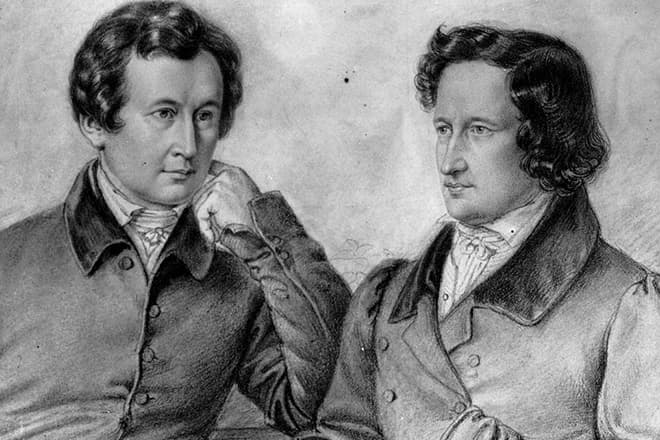
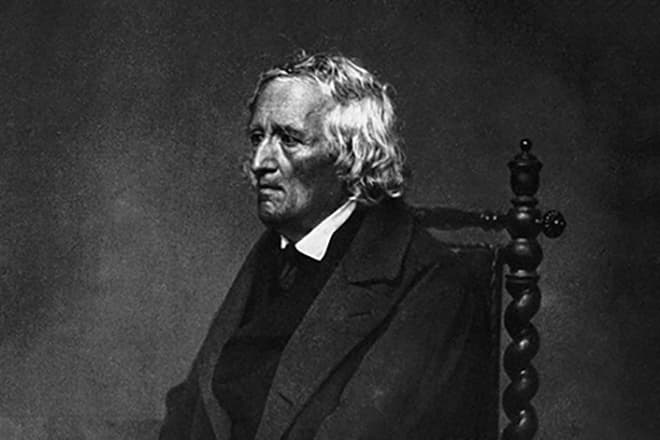
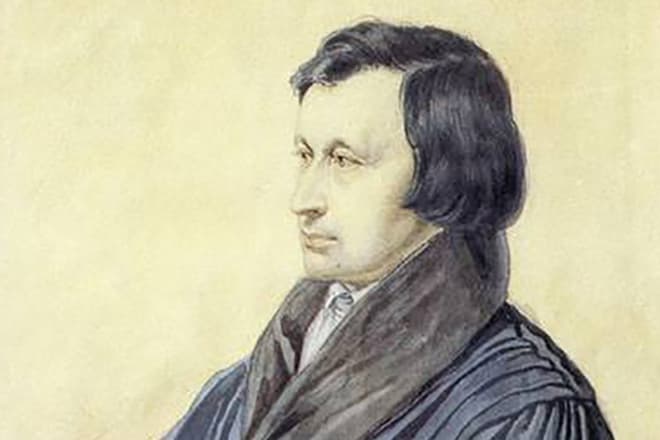
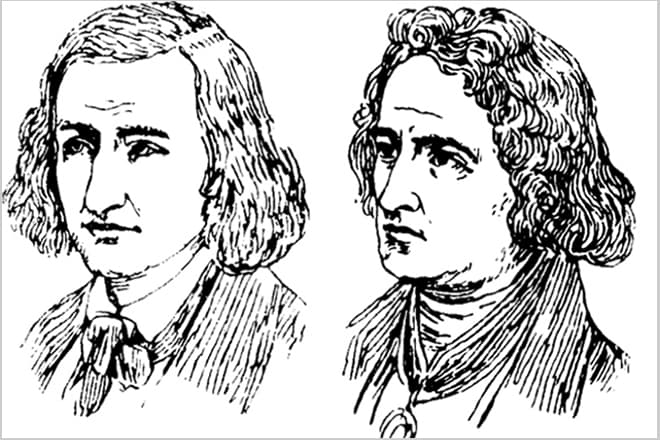
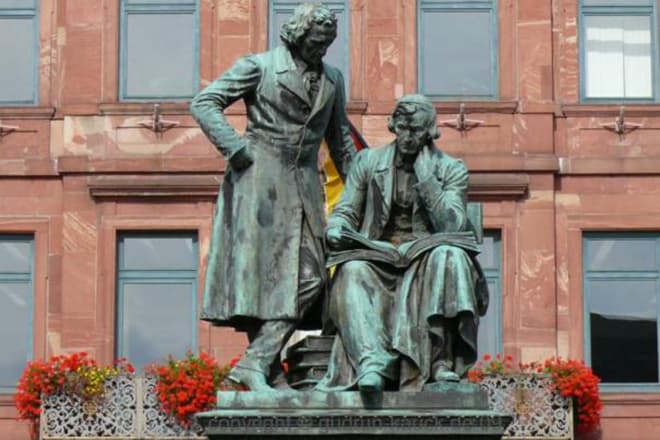

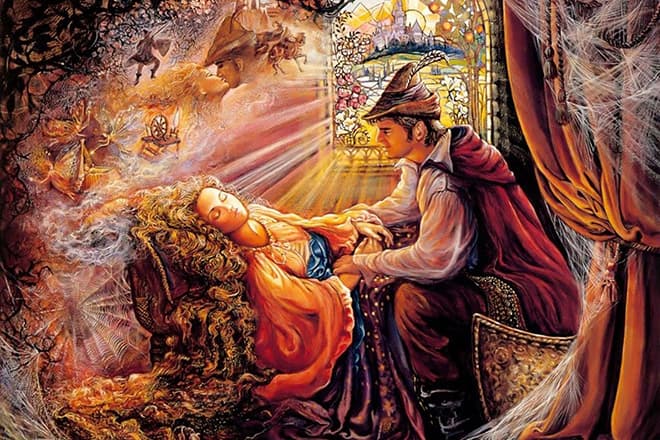
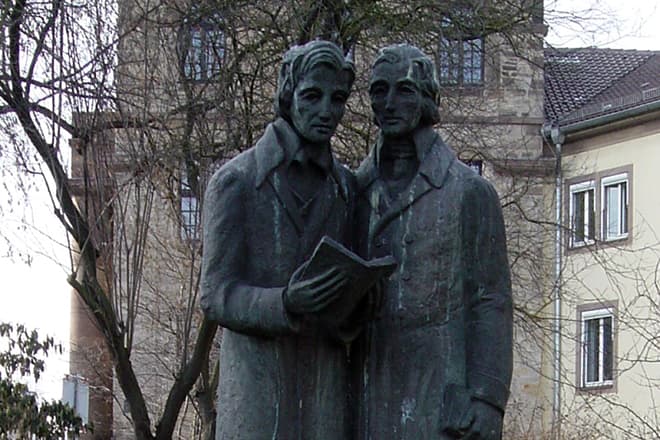
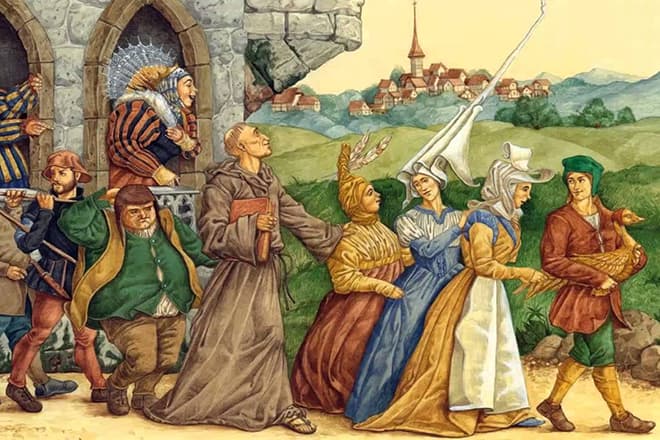

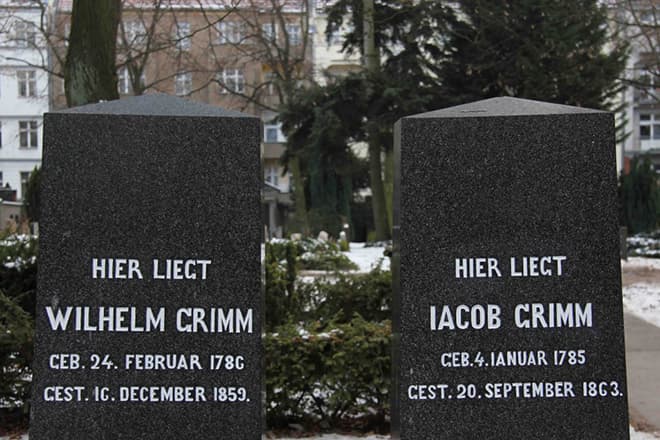
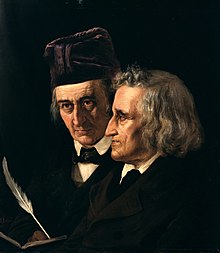


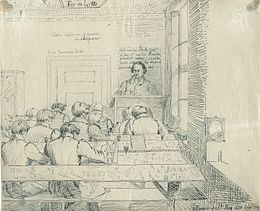

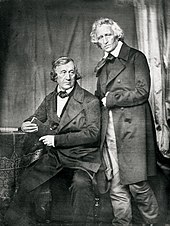



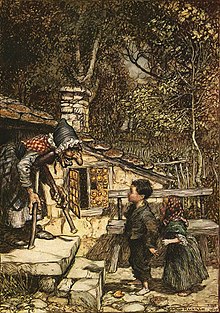




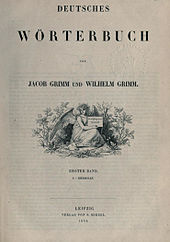

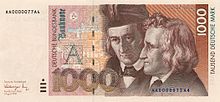

























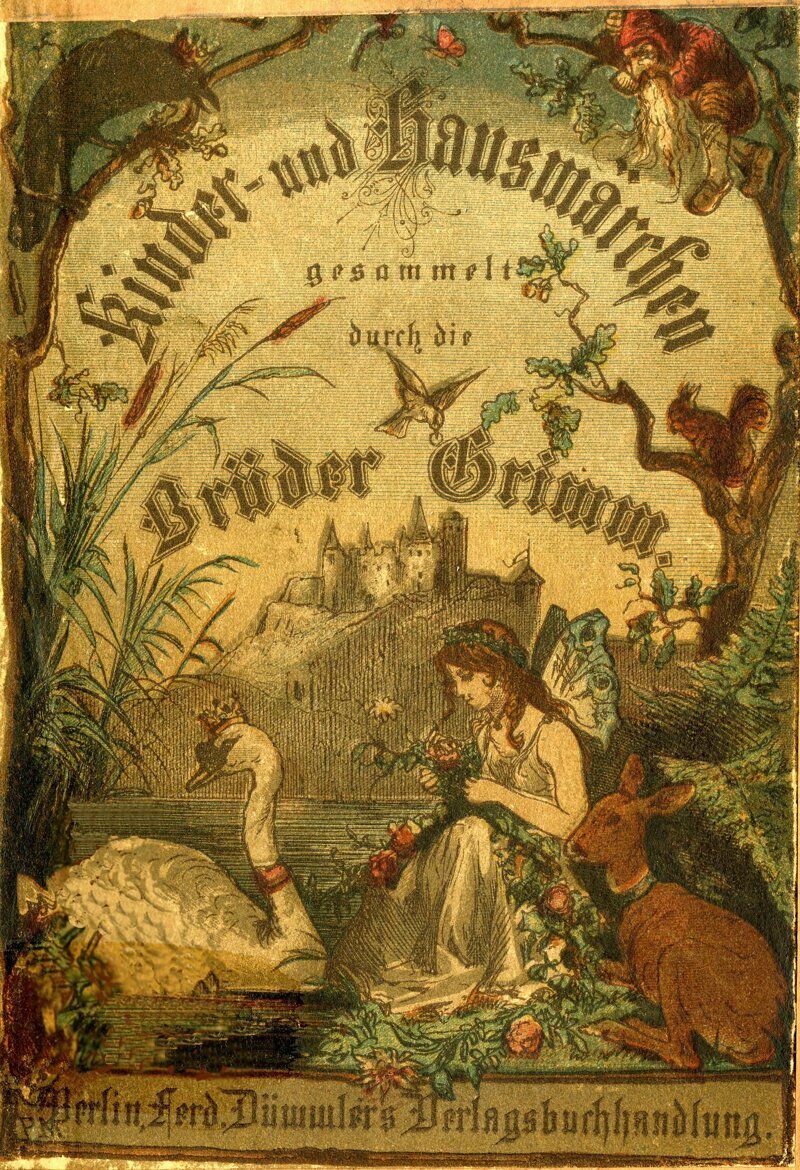
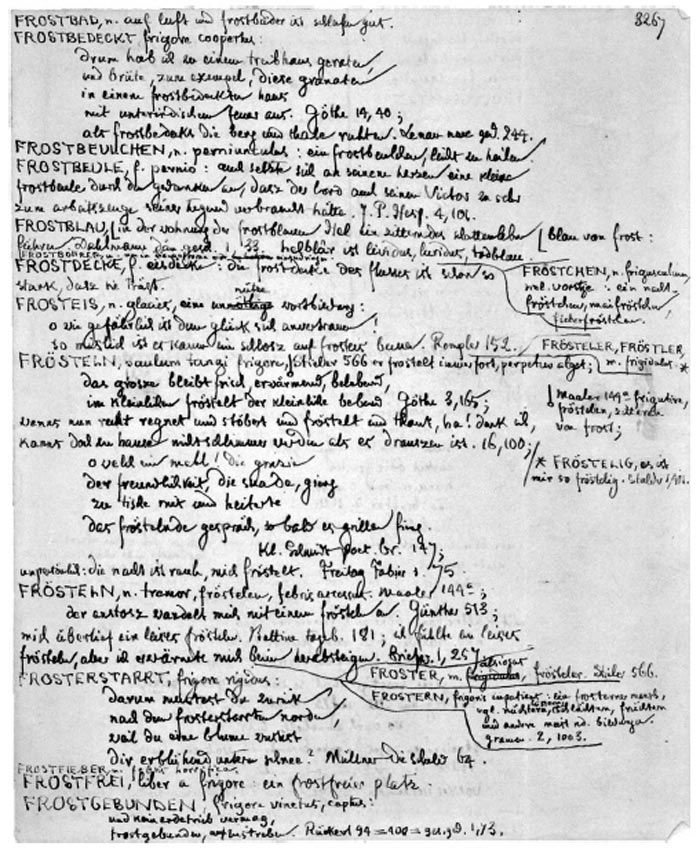
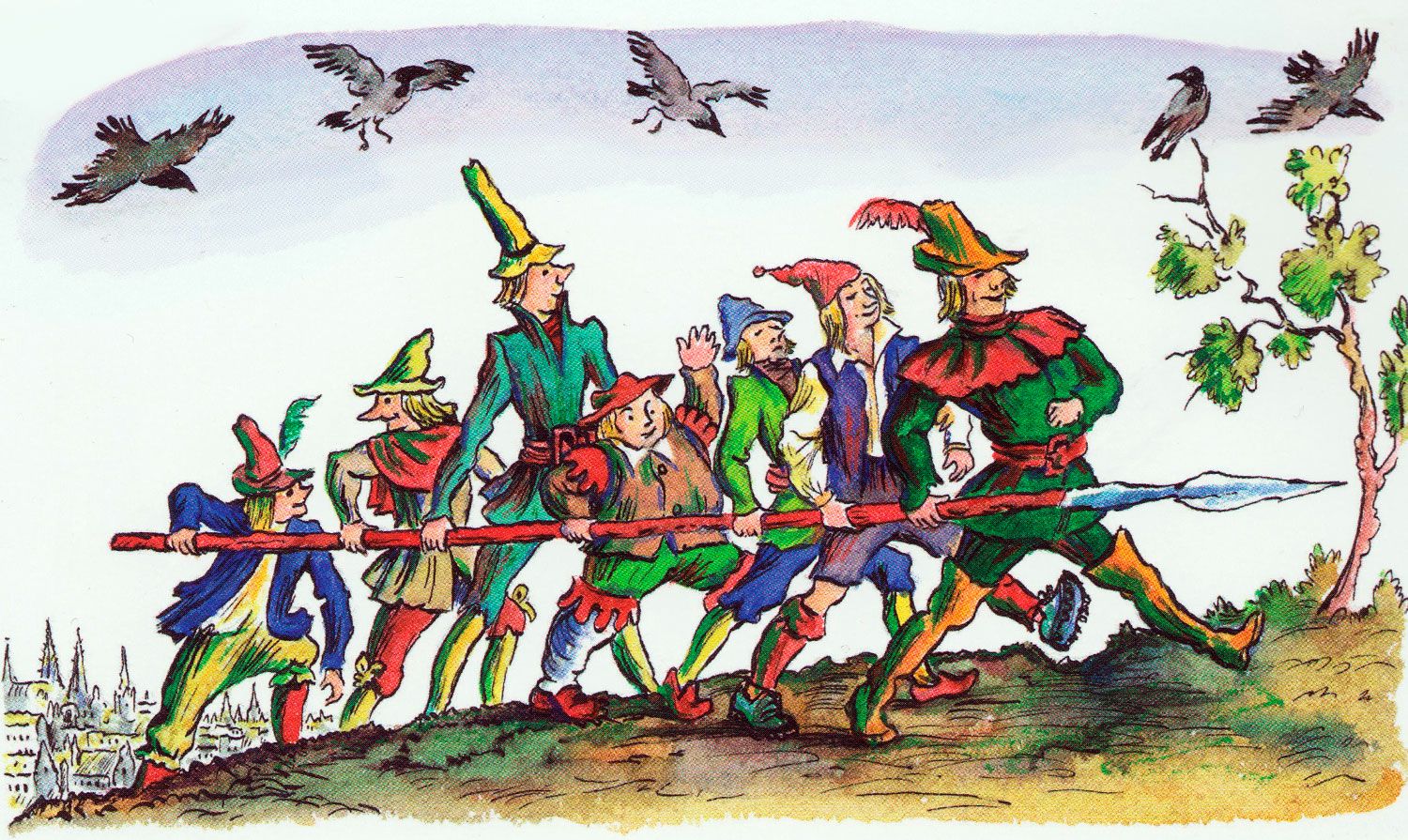
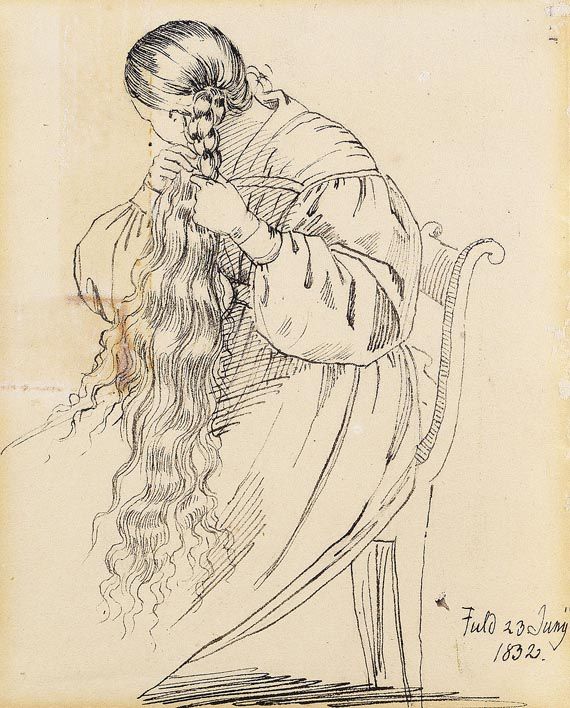
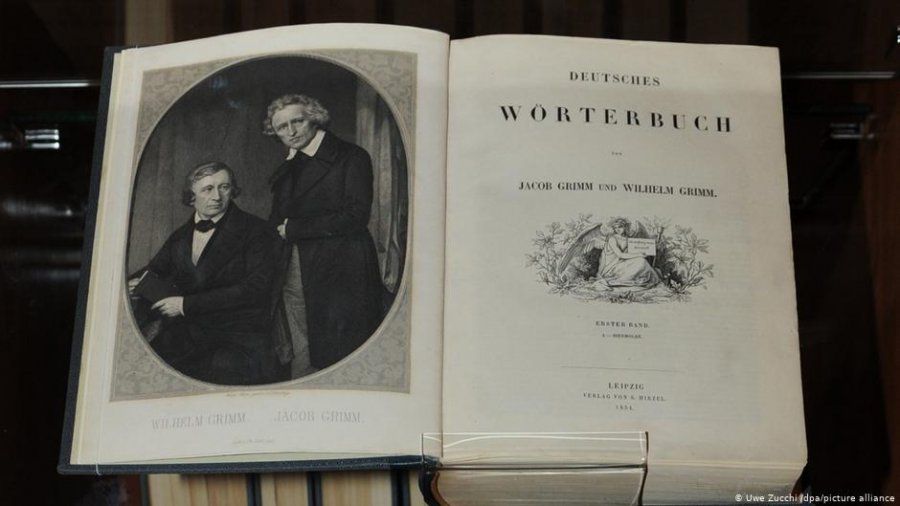
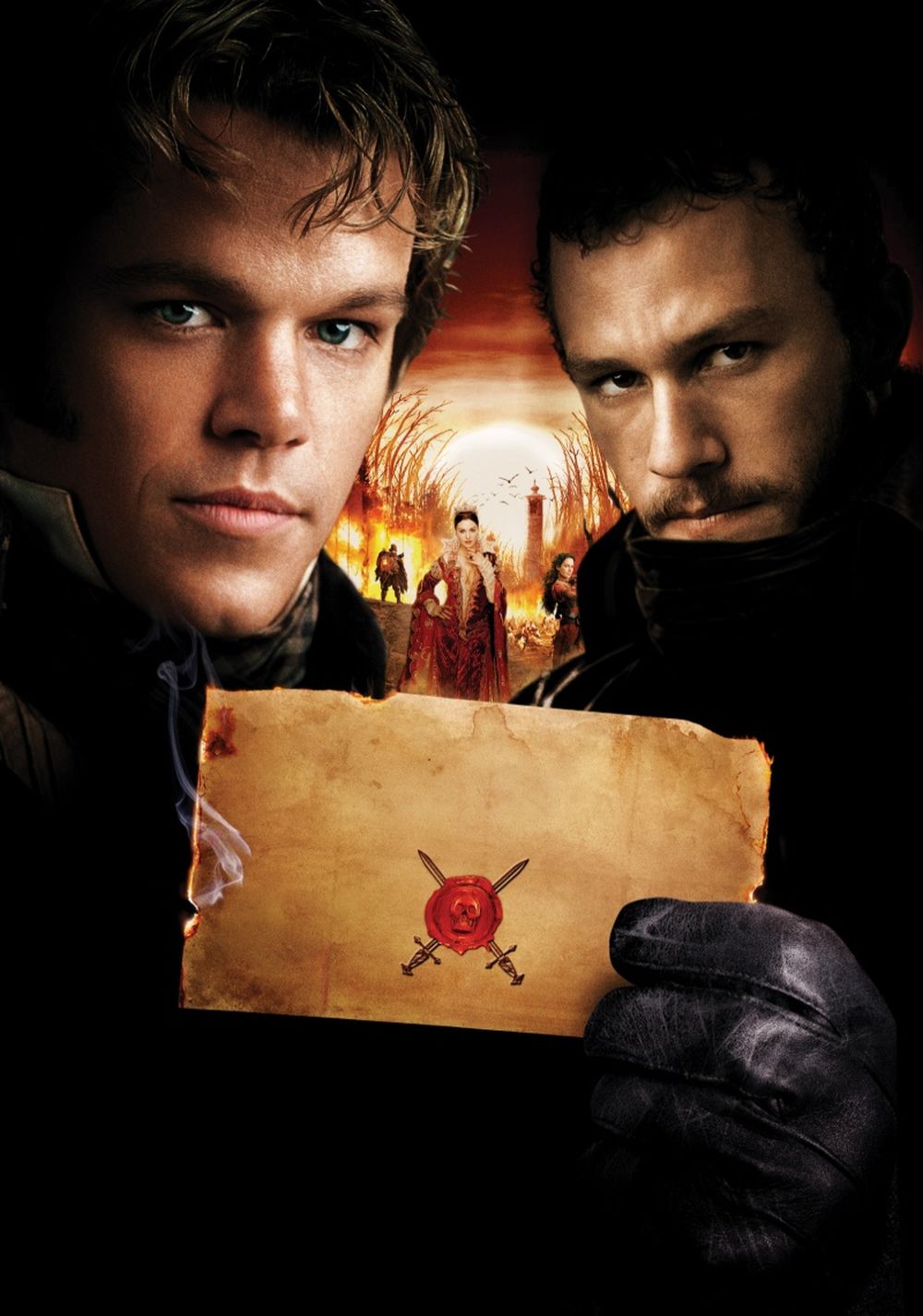
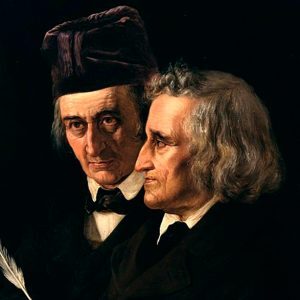 Роль и место в литературе
Роль и место в литературе